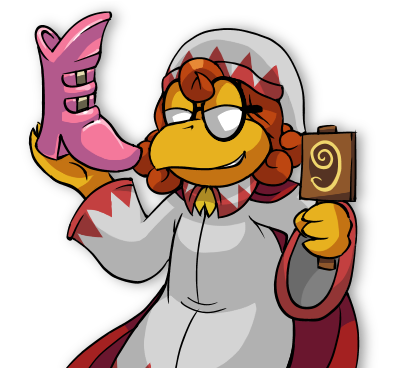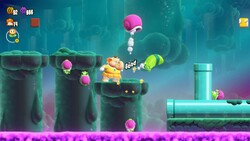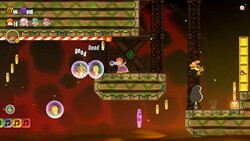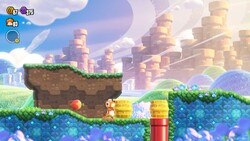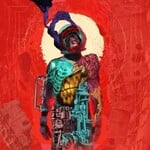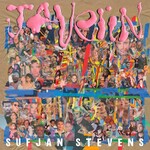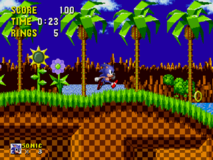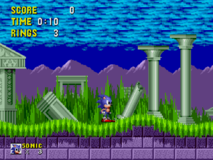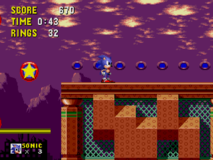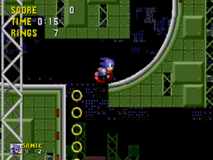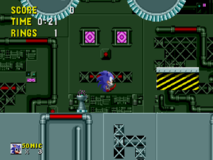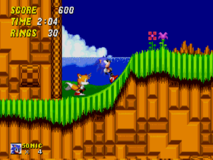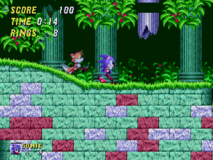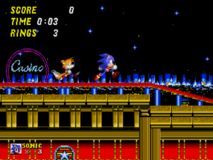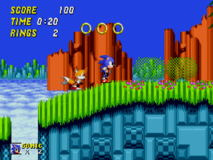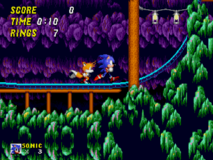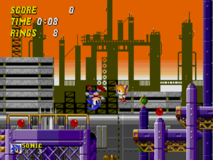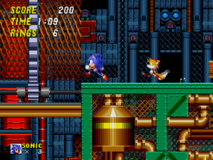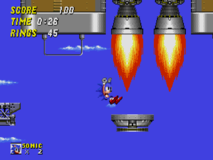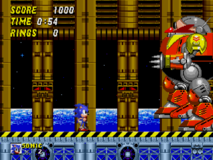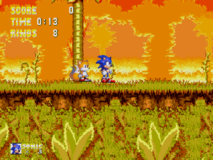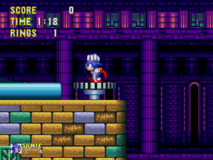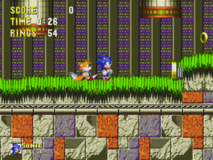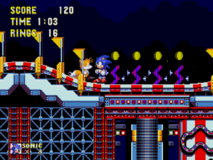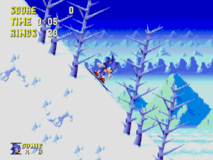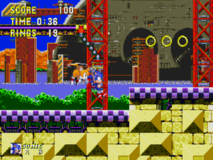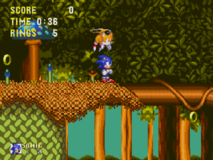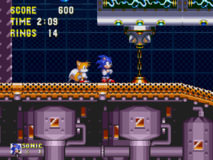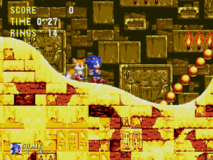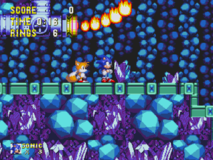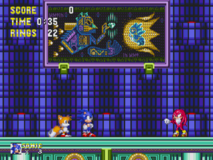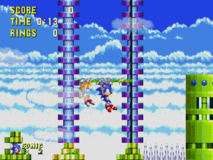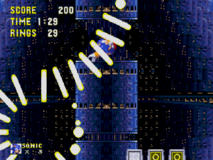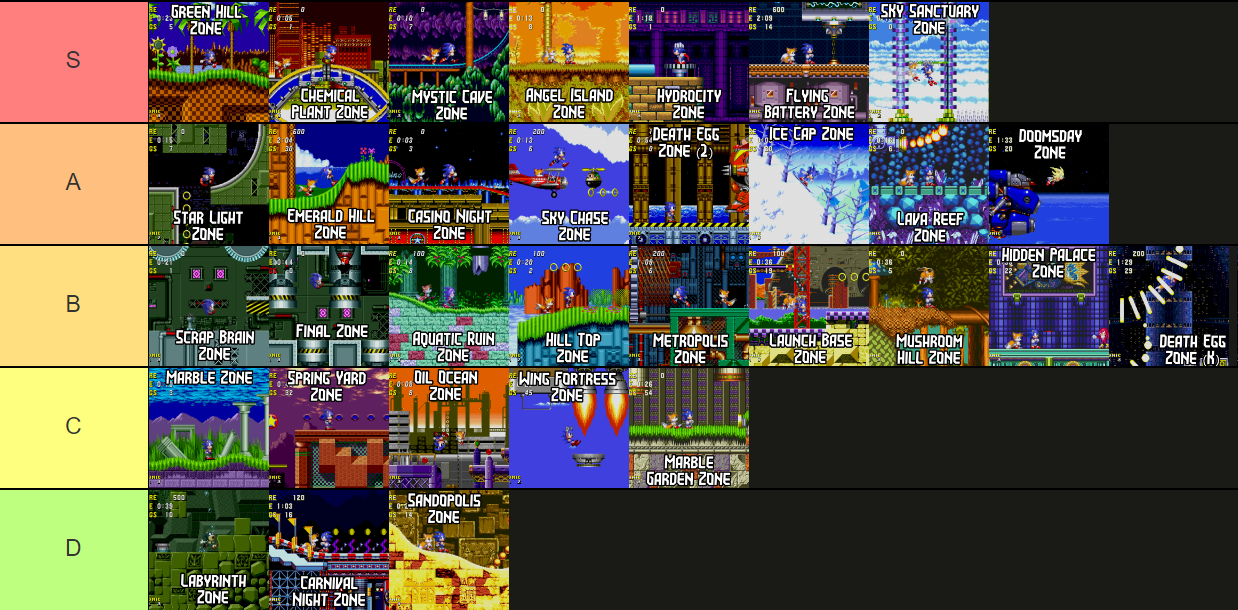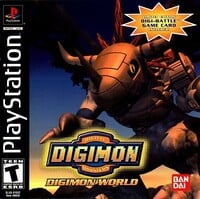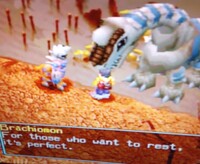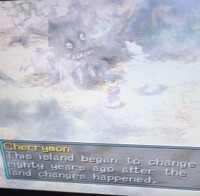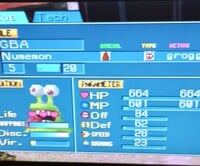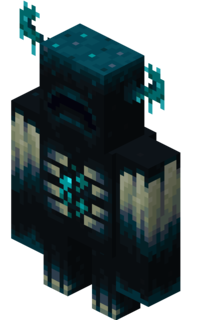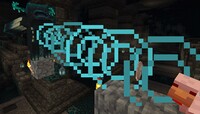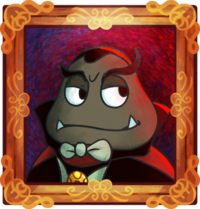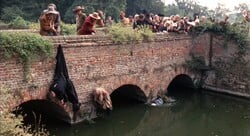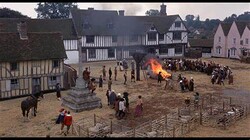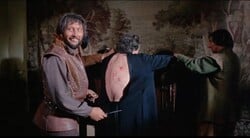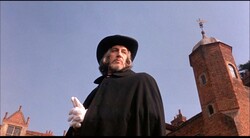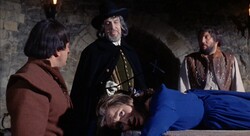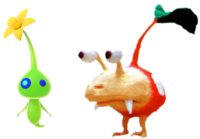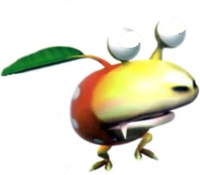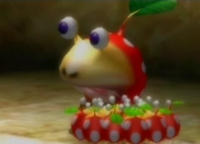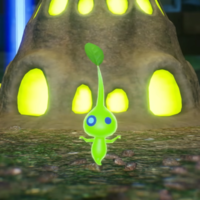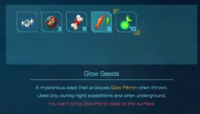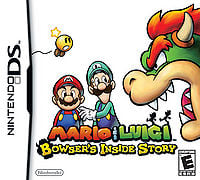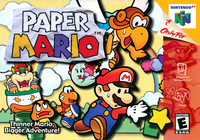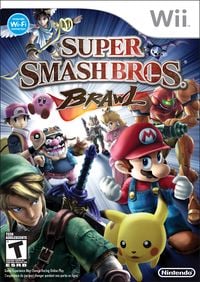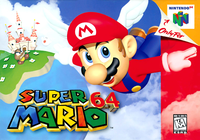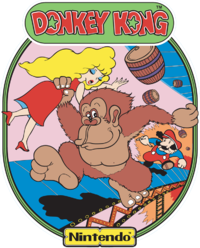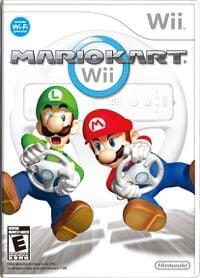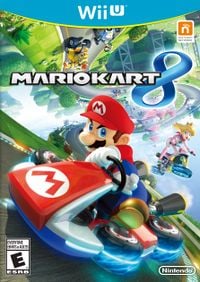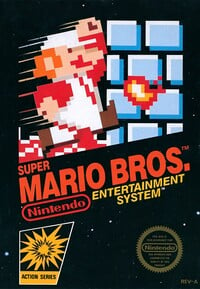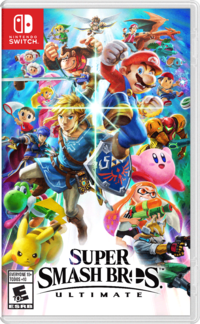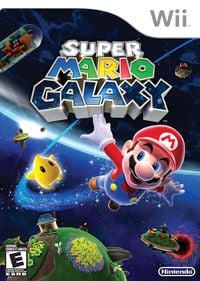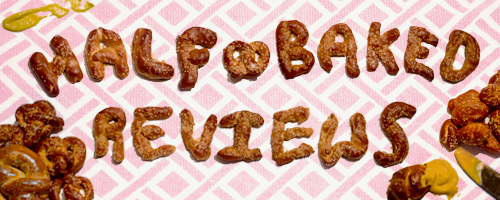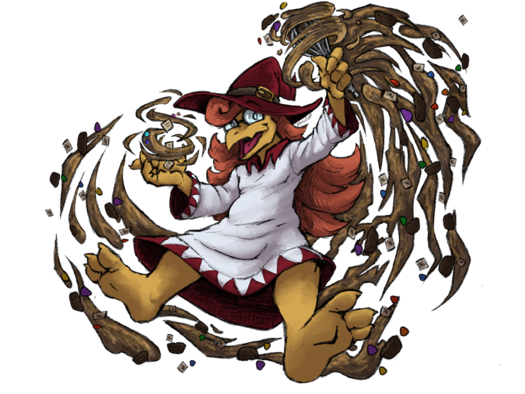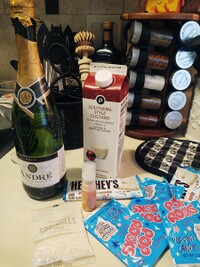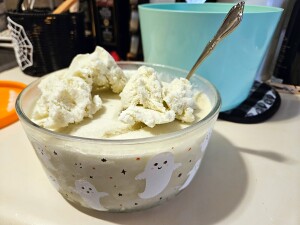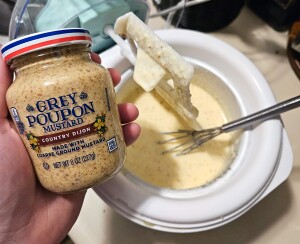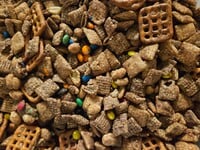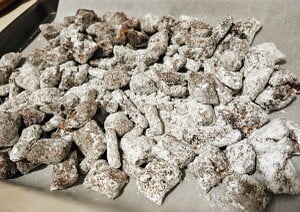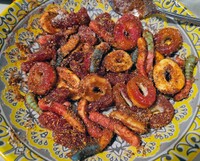The 'Shroom:Issue 200/Critic Corner
Director's Notes
Issue 100 feels like yesterday, but is literally 8 years. I feel like saying it's hard to imagine just how long I've been here (around 14 years now), the longevity of this community, and especially The 'Shroom, but it's really not. If you've been lucky enough to spend some time here it becomes obvious how special--and rare--the community we have here is, embracing our Mario roots and transcending that as close friends together, experiencing passion projects together, enjoying life together, and I know personally has become even more. Thank you to all of you, fellow administrators and long-term community members who've been through thick and thin, people who I can confidently call my best friends who have mutually helped guide each other through life's both tough and fun moments, our writers and community contributors who volunteer their time to share their weird quirks and excitement for art and games, and even to our quiet readers who enjoy our work, who now have a lot to read this month!
Regular sections, special sections, returning sections, and of special note is the final section of Shoey (talk)'s A Report on the Effectiveness of Power-Ups. Energetic, silly, and as always passionately thorough; I will surely miss having this section around but will be looking forward to other projects Shoey will have coming in the future!
Whether through here in The 'Shroom, or elsewhere in life, here's to the next 100 months! 🥂
Thank you for voting Half-Baked Reviews as October's Critic Corner Section of the Month!! Be sure to give your love to all of our sections here, and give a shout out to our writers whether in chat or in their forum threads dedicated to their sections. Be sure to vote vote vote!
And now for my regular announcements: We've decided to implement in Critic Corner, and The 'Shroom in general, something similar to News Flush over in Fake News, where no formal sign-up application process is required for one-time or limited sections. From now on if you just want to send in a single review for something you just read, watched played, tried, whatever, you just have to send me your review privately either to me directly in chat, or in a message to me on the forum at least one week before each 'Shroom is to be released! There's no commitment or obligation to provide a full monthly section (although you absolutely can shift it into one if you so choose), just send us your thoughts on a thing and we'll feature it here! If you have any questions or curiosities about this, please feel free to ask!
As always, if you would like to help Critic Corner, we always have openings for more writers! You are free to write for sections such as Character Review and Movie Review, or really anything you'd like to do! There's no pressure to have a huge section; they can be shorter and concise! The application process is very simple, starting with reading the Sign Up page, and sending your application to Meta Knight on the forum. Any idea you have is welcome, and if you have any questions or need help signing up, please feel free to reach out to myself or other 'Shroom peeps!
Section of the Month
| CRITIC CORNER SECTION OF THE MONTH | ||||
|---|---|---|---|---|
| Place | Section | Votes | % | Writer |
| 1st | Anton's Half-Baked Reviews | 31 | 91.18% | Hypnotoad (talk) |
| 2nd | Van Shoeul's House of Ghouls | 2 | 5.88% | Shoey (talk) |
| 3rd | 'Shroom FM | 1 | 2.94% | MCD (talk) |
A Report on the Effectiveness of Power-Ups
Written By: Generalissimo Shoe (talk)
At ease troops, and welcome to another Report on the Effectiveness of Power-Ups. You might have noticed my two-month absence from this paper and wondered where I was. The answer was simple; I was conducting field tests on this month's batch of power-ups. Unfortunately, before I share the results, I'm sad to announce this will be the final power-up report. After this month, I'm being reassigned to an internal department. But anyways, this month's power-ups are the Elephant Fruit, Bubble Flower, and Drill Mushroom, tree power-ups that all made their debut in the campaign against Castle Koopa during the battles for the Flower Kingdom.
Elephant Fruit
Our first power-up is the Elephant Fruit. Eating an Elephant Fruit turns Daisy and co. into an elephant, and, unlike with most power-ups, the user actually becomes an elephant. Usually with the animal-based power-ups, such as Frog Daisy or Raccoon Daisy, the user would just put on a suit, but not here! With this pachyderm fruit, the user actually becomes an elephant, which is really weird! Elephant Mario is kind of the premier power-up of Super Mario Bros. Wonder, and what I mean by that is. much like Cape Mario, Mega Mario, and Raccoon Mario, Elephant Mario is by far the form with the most prominence in advertisements, and even appears on the box art!
Elephant Daisy has a fairly large variety of powers that have both combat and utility purposes. Its main powers revolve around the trunk. Using her trunk, Daisy can defeat enemies by smacking them with it. She can also store water in the trunk and use it to water dying flowers, which reveal secrets.
Those are the main powers of Elephant Daisy, but the form also has a few utility powers such as:
- Allowing users to run over gaps that are two bricks long
- Extra weight
- Allows users to break multiple rows of blocks at once
- Allows users to defeat certain enemies, such as Shovas, in one stomp
- Extra strength
- Allows users to lift giant shells
- Allows users to hit all the coins out of a block in one jump
So, as you can see, Elephant Daisy has a lot of powers, more powers than most Daisy power-up forms have. But despite this, I feel like Elephant Daisy is really kind of underwhelming. Like, the utility powers are nice, but they feel niches that rarely seem to come up. The storing water idea is cool in theory, but it's not like Ellie the Elephant where the water is a projectile. It can only be used to revive dying plants, and those mostly only give coins as a reward. The best power is probably the ability to use the trunk to defeat enemies. It's very responsive, and you can easily use it to defeat multiple enemies in a row. Here's the catch, though. Most enemies can be defeated by simple stomping, so how much do you really need the trunk?
The elephant form is fine; it's perfectly usable. I get why Nintendo would advertise it heavily, because it's like "hey, look at this weird-ass power-up, what's going on with this?", but that's part of the reason I think it's underwhelming. It's so prominently advertised that you think it's going to be this amazing power-up like Raccoon Daisy or Cape Daisy, but it's just kind of a standard power-up and it doesn't really have any cool or unique gimmicks. There just isn't a lot in this game that really justifies the elephant power existing. It kind of feels like they had an idea for the form first but they didn't have a lot of really great ideas for using it. Of the really heavily advertised power-ups, it's probably my second-least favorite, only beating out the Wing Cap because the Wing Cap is garbage!
Bubble Flower
A close relative of the more iconic Fire Flower, next we have the Bubble Flower. This purple flower, unique to the Flower Kingdom, is very interesting. When released from a ? Block, the Bubble Flower comes out in a protective bubble that floats along, going across the area. Top Mushroom Kingdom scientists believe this bubble prevents the Bubble Flower from wilting due to lack of water. Consume a Bubble Flower, and Daisy becomes Bubble Daisy.
The Bubble Daisy form only has one power and that's, as the name suggests, shooting bubbles. But you'd be surprised how useful these bubbles are. For starters, the bubbles can defeat the vast majority of enemies, even enemies such as Dry Bones and Buzzy Beetles that can't be defeated by the sizzling might of the Fire Flower. The bubbles can also travel through walls, defeating foes hidden behind protective cover.
The bubbles themselves appear to be made out of some sort of dissolving solvent, because when an enemy such as a Goomba gets trapped in one, they're momentarily stunned before being completely dissolved, leaving only a coin behind. Most of the smaller enemies can be defeated by the bubbles, but a lot of the big ones are immune to them. The bubbles even have a slight homing mechanism and will slightly tilt to trap nearby enemies. You can even jump off of the bubbles! They make an excellent temporary platform if you just need a slight boost, but watch out, because this extra jump ability can be a hindrance if you accidentally bounce off of one!
The Bubble Flower is my favorite power-up in Super Mario Bros. Wonder. It's such a simple concept, because all it does is fire bubbles, but the bubbles are so useful and you can fire so many bubbles at once that it becomes a great power-up. You can basically clear out most enemies with the bubbles without being at risk of getting hit. I'd say the Bubble Flower is one of my favorite power-ups in general, because it takes such a simple concept and executes it perfectly! Of the new power-ups in Super Mario Bros. Wonder, I hope the Bubble Flower becomes a staple of 2D Mario games (even though it probably won't!)
Drill Mushroom
The final new power-up in Super Mario Bros. Wonder is the Drill Mushroom. This mechanical oddity, half-mushroom half-literal drill, is probably the rarest of the three new power-ups. Only showing up on its own in a few levels, it can also be picked up in a number of the KO Arena levels as well as in the Roulette Boxes in a couple levels. The Drill Mushroom is pretty similar to Super Mario Galaxy 2's Spin Drill, and, when consumed, turns Daisy into Drill Daisy.
Drill Daisy is a peculiar form. It's, for the most part, the most situational of the new power-ups or even really of all Mario power-ups. As Drill Daisy, you can burrow underground or into the ceiling, allowing you to avoid enemies and obstacles as well as collect coins placed high up or Wonder Seeds. So that's cool, but it's almost got the P-Wing effect going on, where it makes standard levels kind of redundant. The end result is that It can't really be worked into many levels well.
The stylish drill hat can also be used as a weapon! The top of the drill hat is a functional drill and will defeat enemies it comes in contact with. This means that, if you jump into an enemy with the top of your head, you'll defeat them, and that's pretty cool! You can also use it to sneak up on Skedaddlers by burrowing underground and taking them out from below. This can be done on most enemies and is a pretty neat way to get around or defeat them.
That's really all the Drill Mushroom does. Like I said, it's a peculiar power-up and I'm not sure if it's really suited for 2D gameplay. The power itself worked really well in Super Mario Galaxy 2 where it could be used to drill out items or go through planets, but here in a 2D space, it can only be really used for very situational things, which is why it's not the focus of very many levels. I'm just not sure how many times you could really keep it interesting without just breaking the levels altogether, because that's kind of what happens if you use it on a lot of levels where it's not the main power-up. It can basically be used to skip large portions of a lot of levels and make any obstacles meaningless, so I'm not sure if this power-up will ever be used again in a 2D Mario game.
The power-ups in Super Mario Bros. Wonder are fine. It's a good selection, with some of the new ones having interesting concepts or ideas. I think the power-ups sort of suffer from not really being the focal point of the game. Since a lot of the Wonder Seed level transformations either turn you into something new or don't really require power-ups to beat, the Wonder Flowers steal the thunder of the other power-ups. Of the three new ones, I think the Bubble Flower is the most conventional of all the power-ups and would be the easiest to bring back. The Elephant Fruit is just kind of underwhelming and, unless they're going to stick with animal designs going forward, I don't really see it being a mainstay. The Drill Mushroom I think is kind of like the Red Star in the sense that I think it's a little too situational to make a lot of appearances. But the Bubble Flour, with its mostly conventional power-up gameplay, I think fits right in with the rest of the Mario power-ups and I hope it continues to make appearances in the coming wars against Bowser.
'Shroom FM
Welcome back to 'Shroom FM. This is the ISSUE 200 SPECIAL EDITION. As a special treat, you are not allowed to read my section until you have read all 199 previous issues.
Afterbirth - In But Not Of
Let's kick Issue 200 off with some death metal. I'm not hugely into the genre, so I could be completely wrong, but sometimes this does feel a little over-the-top, particularly the song titles. You get the relatively normal stuff like "Time Enough Tomorrow", then a bit weirder with "Death Invents Itself", and then we get into "Hovering Human Head Drones" and "Vomit on Humanity" territory. I'm not saying that's a bad thing, though. I'd imagine the most divisive thing about this would be the vocals - which are so hollow that they're essentially just a gurgle. My feelings towards them were generally ambivalent - would've probably prefered something more conventional (as conventional as 'normal' death metal vocals are), but it's definitely unique. The songwriting is often quite interesting and unpredictable, including plenty of progressive elements - song lengths are generally anywhere between two to five minutes. It's a decent album; it does get a bit tiring towards the end, but on the whole it's very solid.betcover!! - 馬 (uma)
This is the first betcover!! album I've listened to and I think this might've been a bit of a poor place to start, because I'm not getting much from this. This is probably a matter of personal taste but there's some production choices here - particularly with the percussion, and more specifically the cymbals - which I don't like much. At its worst, this can drown out the more interesting elements of the songs, such as the intricacies in the songwriting. My other main criticism of this would be that there's plenty of cool, individual moments I liked - such as the complex piano line running under "炎天の日" and particularly the way the flutes and guitars blend on "鏡" - but the songs themselves didn't do a lot to stand out individually.Sofia Kourtesis - Madres
Madres kicks things off with its bright, upbeat title track - the song wastes absolutely no time, just drops you straight into the album's deep atmosphere. It's energetic but also quite laid-back: the synth line is nice and mellow, the drums are steady, and the rest of the soundscape is built up by these lush vocal sections and samples, which the main verses fade between. By contrast, "Si Te Portas Bonito" takes a lot longer to build up, and the background vocals are pushed to... well, the background, and the lead vocals are much more in focus. There's still background stuff happening, but it's much more subtle. This is my favourite song on the album and I think afterwards it does slowly start to lose some of its momentum... which then drops off a lot at "Moving Houses", an odd 5-minute ambient interlude that appears towards the end of the album. But that's not to say it completely ruins the atmosphere, and there's plenty of fun and intricate songs over the rest of the album's runtime - just never really reaches the highs of the first two tracks. Kourtesis performance and production are both really sharp, so if you're into technical and deep house, it's well worth giving this a listen.Sampha - Lahai ⭐
I'd gone quite a while without thinking much about Sampha, honestly. There were a few tracks from his debut, Process, from all the way back in 2017, that I really enjoyed at the time, but gradually those started to fade from my memory a bit. I didn't really know what to expect when going into Lahai - but the album just blew me away right from the start. What an absolutely incredible soundscape this thing has. Sampha's vocals are really rich; his piano work is sublime, as are the synths and strings whenever they're here; the percussion and drums are, by contrast, often really fast and a bit glitchy - and the way this is all layered just feels so immense and inventive.Sufjan Stevens - Javelin ⭐
This has been a great year for songs that just burst to life partway through; and just about every song here pulls that off gorgeously - many starting off quiet and acoustic, with Sufjan's tender vocals right at the centre, then the backing vocals slowly fade in, and then this huge, lush electronic wall of sound just swells up. The album is dedicated to Sufjan's late partner, Evans Richardson IV, who passed away in April this year - plenty of the lyrics deal with loss and relationships, and the raw emotion here contrasts really well with these huge instrumental crescendoes. Sufjan's lyricism here is sharp and intimate, and it's really hard not to get drawn in. It's a wonderfully bittersweet album, all in all.Further listening
- Ana Frango Elétrico - Me chama de gato que eu sou sua is very nice. I thought their previous album had a bit more warmth to it, but there's plenty of great stuff here.
- DJ Sabrina the Teenage DJ has released a drumless version of Destiny. I haven't listened to it but if you hate drums but love four-hour long house albums this is probably the optimal listening experience.
- I went to see tricot live this week. They were superb!!
Sonic Origins Ranking
Written by: Meta Knight (talk)
Synopsis
In this section I will be assigning a tier list ranking for every "Zone" throughout classic Sonic games. The entries that will be featured are the following: Sonic the Hedgehog, Sonic the Hedgehog 2, Sonic the Hedgehog 3, and Sonic & Knuckles. I am aware that the definitive way to experience Sonic 3 or Sonic & Knuckles is the combined Sonic 3 & Knuckles, but I'll be giving each their own section.
A zone usually consists of two to three “Acts” (some even have only one). The player must go through each level, and at the end of the zone usually features a boss. I will be judging each zone using a variety of factors, including level design, aesthetic, music, cultural impact, etc. Sometimes it just boils down to whether or not I personally enjoy playing through a zone, but generally levels I find fun will rank higher than levels that aren’t. These will be under the assumption that you're playing as Sonic, with Tails tagging along in Sonic 2 and Sonic 3. I’ll also outline the thresholds for what determines each rating.
- S Tier - The absolute best. The cream of the crop. Something in this category has to be perfect, or the flaws are so minimal that it just comes off as a nitpick.
- A Tier - Reserved for things that aren’t quite as polished as things in S Tier, but still an absolute joy to play through.
- B Tier - The baseline for what a decent stage is. It’s not something I have strong feelings about, but generally I would consider it serviceable or good.
- C Tier - Something that I feel nothing about. It’s not good, it’s not the worst, but in general pretty mediocre. Something super boring, forgettable, or “mid” as the hip crowd would call it.
- D Tier - Terrible. Things that I dread playing through, and range from bad to the absolute worst.
With all of that out of the way, let’s get started with the original Sonic the Hedgehog!
Sonic the Hedgehog (1991)
Sonic 1 was the start of it all; kickstarting a massive franchise and enabling Sega to have an iconic mascot. It also hasn't aged the best. I am somewhat of a Sonic 1 apologist, because despite knowing how genuinely awful some of the levels are, I think I actually end up playing it more than the other games. It doesn't mean I think it's the best, nor is it my favorite, but something keeps pulling me back to it. Perhaps I just "got good", but that doesn't excuse some of the baffling design choices.
Green Hill Zone - S
Do I even need to say anything for Green Hill Zone? Everyone has talked about it to great lengths already. I mean, it's the Sonic level. There's a reason it keeps coming back whenever a Sonic game has some sort of throwback. Everything from the music to the visuals is nothing short of iconic. Beyond that, it is actually the best zone in Sonic 1. In fact, some people would say the most optimal way to play Sonic 1 is to play through Green Hill Zone, then shut the game off. Can't say I blame them. A nice balance of speedy sections, with a few platforming challenges along the way without ever feeling bogged down.
Marble Zone - C
Marble Zone is where Sonic 1 throws its first roadblock. Many people fail to get past Marble Zone, quitting from either boredom, or frustration as a result of continuously dying to poorly placed obstacles. There are several spots where you're just waiting. Green pipes move up and down, and you need to wait for the right opportunity to clear them. However, Sonic 1 doesn't have a Spin Dash, so it's easy to die from getting crushed. There's also blocks you push into lava rivers, so for these you do nothing for a good 10 seconds. As far as awful design goes, you'll do a series of jumps, then a spring or spike pops out to instantly kill your momentum, and make you fall to do it again. Sonic 1 also does not provide invincibility frames for spikes. So if you get hit and land on a spike, that's a death regardless of whether you had rings or not. Ironically enough, the boss is one of the easiest in the game. Despite the objectively flawed aspects of Marble Zone, I can get through it relatively quickly just because of how much I've played Sonic 1, so I don't particularly fear playing through these levels, and I don't think it's the absolute worst. I also like the music, and the color scheme is more vibrant compared to some of the other stages. That won't stop me from empathizing with the countless other players that Marble Zone defeats, such as this person:
Spring Yard Zone - C
Spring Yard Zone for me has a lot of the same problems as Marble Zone. Thankfully, there aren't as many hurdles that are straight-up foul. Unfortunately, there's several points where you're standing still for moving platforms to move vertically, and you want to just keep moving but can't. Additionally, each Act genuinely feels the exact same, and similar subsections within a level give off the impression that they're copy-pasted throughout. At the very least, the branching paths are a bit more interesting with some switches you can toggle. The visuals are a bit boring as well.
Labyrinth Zone - D
This is without a doubt, the single worst zone not only in Sonic 1, but throughout all of the Genesis Sonic games. Imagine having the slow, monotonous pacing of Marble Zone, complete with the unfair hurdles, and then do it again but infinitely worse. The introduction of water is the main culprit. Sonic cannot swim, and he moves incredibly sluggish while sunk. If that wasn't enough, know that unlike other 2D platformers at the time Sonic can drown. The only way to survive is to wait for bubbles to form out of the ground in dedicated spots. There's also several spear objects that extend from the surrounding tiles. They can be tricky to maneuver around, especially when underwater. Other atrocities in Labyrinth Zone come in the form of troublesome design. For instance, a common theme of good game design is to introduce a mechanic in a safe spot, then make it slightly more challenging with a similar one later on. Labyrinth Zone breaks this by having a moving platform on a conveyor belt move you upward into a spike, killing you regardless of ring count. Insultingly, the next time you're on the same sort of conveyor belt, there's no spike. Why couldn't they put the safe one first, and visually indicate that "hey there could be spikes here" to prepare players for future encounters? The reason is simple: Labyrinth Zone is complete trash. The aesthetic is ugly, the music is unappealing, and I hate the Eggman encounter in Act 3. It contains all of the problems of Labyrinth Zone in one concentrated segment.
Star Light Zone - A
If you've managed to make it here in the game, then congratulations! Your reward is the only other zone in Sonic 1 that can be considered "great". The music is pleasant; so calming and a welcome change compared to the hellhole of Labyrinth Zone. Star Light Zone actually allows you to go quickly throughout, which is what classic Sonic is all about. There's everything you'd want in a Sonic level including slopes, loops, and platforming, without any lollygagging. It also features seesaws that are a fun way to propel yourself upwards. The boss is pretty clever too! You can either use the seesaws to hit Eggman directly with spiky bombs, or use the trajectory to bump yourself up into him. Either way is easy, but I appreciate that you have multiple options compared to some of the other bosses.
Scrap Brain Zone - B
Scrap Brain Zone is one continuous death trap after another. By all definitions of the word, it is complete bull crap. Platforms suddenly disappear from underneath when you step on them. Conveyor belts that pull you into saw blades or large crushers. Several rows of bomb enemies, narrow corridors, lighting floors, upward flames, and many more. You would think that makes it the worst, but because it's the last area in the game, I find it a little bit more forgivable. It's the last stretch, it should be difficult. Genuinely, if this was a list of Eggman's smartest plans, Scrap Brain Zone would be near the top. Unfortunately, Act 3 is just more Labyrinth Zone which is a huge detriment. Luckily, you can run quickly at the start and drop down to cut the length significantly. Scrap Brain Zone's level tune and views really sell the idea that you're in a laboratory, Act 3 aside. Despite its level design flaws, I appreciate Scrap Brain Zone for what it is.
Final Zone - B
Final Zone is a singular boss fight. No rings, no nonsense, just you and this one fight. It doesn't have any of the arbitrarily placed obstacles like many of the lesser zones which is a great benefit. The music sets the tension tonally, so it does indeed feel like a Final Zone. The boss fight itself is pretty easy for me though. You jump between some electrical spheres, dodge the crusher, and hit. You do this over and over until you win, and that's it. Overall, Final Zone does the job and once it's over you can stop playing Sonic 1 so there's that.
Sonic the Hedgehog 2 (1992)
Sonic 2 improves on the original in every way. The Spin Dash enables a quick boost of speed on the fly, greatly reducing the amount of times anything feels sluggish. Also, most zones are now 2 Acts instead of 3. This means you get involved with the levels for just the right amount. Nothing overstays its welcome, while still providing a memorable experience. That's not to say everything is perfect, but the highs are higher than in Sonic 1, and the lows are not as egregious. Sonic 2 also brings in Tails, who is personally my favorite out of the classic cast of characters. Without any further dawdling, let's get into the rankings.
Emerald Hill Zone - A
Emerald Hill is a great introduction to Sonic 2. It's basically Green Hill Zone, but new and different. That being said, the visuals and music are unique enough, and memorable in their own right, to make Emerald Hill feel more than a direct copy. Emerald Hill isn't quite as iconic as Green Hill Zone, and not even the most popular in Sonic 2, but it's still a really well-made set of stages. There's just some other zones that are better, that's all.
Chemical Plant Zone - S
Many players love Chemical Plant, and it's easy to see why. Firstly, the music is an absolute banger. The stage itself is a nonstop rush throughout all of the loops, ramps, spring boosts, pipe tubes, and more. There's a couple of spots that require some platforming skills, but it never feels like it's slowing things down. Act 2 features some pink fluid that you can drown in, which I got stuck on a lot as a kid, but it's pretty easy to get past. All in all, it's no wonder that Chemical Plant keeps returning to represent anything Sonic 2 related. Simply put, it's a blast.
Aquatic Ruin Zone - B
Aquatic Ruin is certainly a unique stage. Throughout each Act, you can take an upper or lower path. One of them leads you across the surface, and the other underwater. You won't have to worry about drowning on the high ground, but otherwise you'll need to stop for bubbles. Aquatic Ruin is fine, but has some design flaws. For instance, the road above water is pretty speedy, but frequently places Grounders and other enemies that you suddenly get hit by. Conversely, underwater is a bit of a slower route, but is somewhat safer. Navigating water in Sonic 2 isn't as treacherous as it was before thanks to the Spin Dash, so there's that.
Casino Night Zone - A
Casino Night is certainly a vibe. In fact, the appearance and audio all lend themselves to the feeling of being in, well, a casino. Flashy lights and bright colors are at the forefront set upon a crisp nightly backdrop. The level itself contains several mechanics to compliment this, from pinball levers, slot machines that can get you rings, elevators reminiscent of those in a Las Vegas hotel, etc. Unfortunately, Casino Night for me is held back a little mainly because of two factors. I don't like the springs throughout that you have to hold a button before you can get launched, and ricocheting back and forth between bumpers can get annoying if you're stuck. However, that's just a personal preference really and borderline nitpicks. Casino Night is incredibly solid otherwise.
Hill Top Zone - B
Showcasing gondolas, seesaws, and more, Hill Top is good. The melody is pretty groovy too, and I appreciate the way the level naturally weaves from the surface to underground layers. Some segments have you rush through rising lava, which is a good way to create tension. While it is objectively a well-designed set of stages, I don't feel particularly strongly about Hill Top. That doesn't mean it's bad by any means, but it doesn't leave as much of an impact on me as some other levels.
Mystic Cave Zone - S
For me personally, Mystic Cave has some of the best atmosphere throughout Sonic 2. The scenery is dark, with a lot of green and purple creating a locale that's super interesting. There's also plenty of traps, spikes, and other gadgets to help you navigate, but nothing feels out of place. The melody is also pretty catchy, sounding like something out of a rave. I love going through different ways, jumping to different levers for lowering various platforms. Narrowly escaping crushers is super satisfying as well. The one major downside of Mystic Cave is the infamous pit in Act 2 where if you fall down, you're trapped, and the only way out is to die. In Sonic Origins, they actually changed the behavior so that it leads to previously cut content, therefore making it more worthwhile. Either way, the sheer memorability of Mystic Cave outweighs the negatives.
Oil Ocean Zone - C
Sorry Oil Ocean fans, but I don't like Oil Ocean. There are some interesting ideas, like some green pressure plates, wind turbines, etc. Branching paths are present too, and it feels like a bit of a maze at some point. The boss fight, while slow, is a bit more involved compared to earlier levels, so that's a benefit as well. The music, setting, and visuals serve their purpose well enough. I don't know, it's not like there's anything inherently bad with Oil Ocean, but it just doesn't click for me. I'm not sure if it's just the midpoint of the game where I start to get fatigued, or something else, but every time Oil Ocean starts I get bored and want it to end.
Metropolis Zone - B
Metropolis Zone is noteworthy for being the only set of stages in Sonic 2 with 3 Acts instead of the usual 2. Similar to how Emerald Hill is a spiritual successor to Green Hill Zone, Metropolis is the reincarnation of Scrap Brain Zone. One death trap after another, with troublesome enemies that pop out at you at any given moment in this mechanical plant. Metropolis is the closest it gets to reliving the worst aspects of Sonic 1. On an objective level, it's seriously flawed because of that. For some reason though, I love Metropolis. It keeps you on your toes the whole way through, and being under that sort of pressure is exhilarating. I do understand that there is a lot of bull through these stages though.
Sky Chase Zone - A
Sky Chase is pretty simple, and in terms of gameplay is reminiscent of a 2D space shooter. You just stay in one place, dodge lasers, and defeat enemies. The main reason why I rank this highly, is because Sky Chase is in exactly the right spot, serving the precise role it needs to. At this point in Sonic 2, you've just been through the most difficult part of the game, so Sky Chase lends itself as a more calm environment. The music is peaceful, but there's a sense of "this is the end" as well which is exciting. Some might find Sky Chase a bit boring, but I think it's well-rounded enough considering how much shorter it is.
Wing Fortress Zone - C
The reason that Wing Fortress is held with a lower view in my mind, is because of how dull it is. I would much rather have it be skipped entirely. A notable problem with Wing Fortress is a couple of specific elements. For one, there's these monkey bar segments where you're underneath the ship, and the goal is to jump onto a moving platform to the right. However, there's also flaming exhaust ports, so balancing all of that leads to a narrowly tight jump that doesn't feel like it's even possible. A different but more annoying part of Wing Fortress happens right after a particular checkpoint. There's a large gap, and the only way to get across is to step on a certain spot that'll zip you across. Unfortunately, sometimes it just doesn't work, so you just die. In both of these examples, a death happened and it doesn't feel like you as a player made a bad judgment, rather a direct fault of the game. Metropolis has elements like these too, yet most of them just result in a loss of rings, so that isn't as severe of a consequence for failure.
Death Egg Zone - A
The finale of Sonic 2 lies in the Death Egg Zone. Personally, I think it's an upgrade from the Final Zone featured in Sonic 1. There's two phases here: Silver Sonic, and the Death Egg Robot. Both of them require you to be aware, because you're not allowed any rings. Honestly, it would be more stale otherwise because then you could blindly get a hit, take damage, and grab a leftover ring. Fighting Silver Sonic again after dying on the Death Egg Robot can be a bit troublesome, but I got to the point where Silver Sonic was super easy. The music during the Death Egg Robot is emotional too, perfectly conveying the fact that this is the final battle. Learning the correct patterns, to then overcome the challenges ahead are part of what playing a good video game is all about. In that sense, Sonic 2 ends on a high note.
Sonic the Hedgehog 3 (1994)
Sonic 3 did not have to do nearly as much refining as its predecessor. Sonic 2 obviously was a critical and financial success, so I imagine a lot of high expectations were placed upon this third entry. Sonic 3 continues the formula laid out from the previous games, but each Zone takes more of an expansive direction in the design. This lends to a lot of them feeling like places in a world, rather than a series of levels. While the Acts are longer, it also means there's less of them. On its own, this makes Sonic 3 seem shorter, which some might see as a bit of a downgrade at the time of its release. I don't really care personally, since I play with Sonic & Knuckles attached, but we'll get to that "second half" later. Sonic 3 did bring in the elemental shields, debuted Knuckles as a character, added a save system, so there is merit to the game as it is. I also appreciate that each song between Act 1 and Act 2 is a different spin on the same overarching theme.
Angel Island Zone - S
I cannot think of a better way to start off Sonic 3 than what already happens through Angel Island. You get an opening cutscene to briefly get you up to speed on what's happening, then off you go! Angel Island is yet another grassland, but feels more distinct than Emerald Hill. This probably is due to the fact that halfway through Act 1, the entire place lights on fire! The entire scenery changes to be burnt yellow instead. Act 2 features an airship sequence where you're running past bombs that are being dropped! Green Hill in Sonic 1 is iconic because of how it represents the Sonic franchise as a whole, but Angel Island does a better job at being memorable for the specific events that happen throughout. An excellent set of stages.
Hydrocity Zone - S
Let's ignore the debate on how to pronounce the name of the area for this segment. Hydrocity is another fantastic set of stages in Sonic 3. Obviously, there's a lot of water in the stage, but it doesn't feel slow like Labyrinth Zone, and the transitions between the surface and sunken areas are intertwined with more fluidity than Aquatic Ruin. You can speed through pipes throughout Hydrocity, and watching Sonic loop back and forth with 3D perspective is impressive for the Genesis. There's moving platforms, a chase sequence, hand spinners that give you a boost, good stuff. The music is phenomenal: Act 1 has a jazz funk to it, with Act 2 picking up the tempo to compliment the faster pace, and is one of my favorite tracks in the entire franchise. Overall, Hydrocity is something I've appreciated more over the years.
Marble Garden Zone - C
I don't even want to talk about Marble Garden because there's nothing to say. In fact, the first time I heard about Marble Garden being a thing I thought someone was referring to Marble Zone with the wrong name by mistake. It's just so boring. I'm not a fan of the color scheme, the music, and there's these awful spinner platforms that you're supposed to use, but they don't control well at all. I mentioned that Sonic 3 has longer levels in general, which feels like they're meant to be explored a bit more. However, Sonic 3 keeps the time limit. Some people don't even realize that there is a time limit, but there is a clock that counts upwards, and if it reaches 10 minutes, you die. What this means is that Marble Garden is trying to have an elaborate layout, but it feels like it takes forever to get through with not much payoff for discovering different pathways. This is a problem throughout Sonic 3, and while Marble Garden is not the only zone to do this, nor is it the worst Sonic 3 has to offer, it's the most boring in the game.
Carnival Night Zone - D
Carnival Night is home to the infamous "drum of doom". There's a particular part in Act 2 where the only way forward is to press down on a spinning drum to lower it, thereby allowing access to a lower corridor. The game never tells you that this is a control mechanism you can do, so many children got stuck at this point, ran out of time, then died. I do know the correct way to get past though, and I still struggle to make it to the end of the stage within the time limit. There's several points where you end up making giant circles, especially when finding the special stage rings. As far as the music, I hate it. It does give off the carnival vibe, but something about it I just find grating. In fact, subsequent releases of the game changed the songs from this zone onward due to licensing issues, but I don't miss the original version of Carnival Night's theme. Carnival Night isn't stupid enough to be a fun-bad, and it is annoying to the point where it's my least favorite set of stages in Sonic 3.
Ice Cap Zone - A
Ice Cap whooshes you down a snowy slope and rewards you with 40 rings just for watching the sequence happen. They say first impressions are vital, and Ice Cap starts off wonderfully. I mentioned that some of the music was changed for various themes, and Ice Cap is the song I missed the most when replaying the game in Sonic Origins. Fun fact: the real song for Ice Cap is called Hard Times by the Jetzons, and is worth a listen for any Sonic fan. There's also ice caverns, sliding blocks, penguins, and so many other fitting obstacles. Mainly it's just rewarding to have something more vibrant, and fun to play, even more so after going through the stale Marble Garden and irritating Carnival Night, but then Ice Cap is great to experience in its own right too.
Launch Base Zone - B
I don't have any particularly strong feelings for Launch Base either way. It does suffer from feeling bloated like Marble Garden, but at least there's some more visually interesting elements here. We've got rotating cylinders, levers that change direction, spinning tea cups, ziplines, and things like that. I cannot stress how much I dislike the fact that the timer in Sonic 3 goes against the level design. Launch Base Zone goes several different directions you could get thrown into, so if you get lost just trying to navigate it feels like a slap in the face when the timer inevitably runs out. In one instance, "I died in a cutscene" which was hilarious, but also really stupid. Also, if you're playing with just Sonic 3, the finale is pretty anticlimactic. Literally, you have a phase 1 fight with Eggman, watch Knuckles fall down a pit, then have a second phase, and it just ends after that. By the way, dying later on means you not only restart the first Eggman segment, but you have to watch the cutscene sequence every time. There's no tension either because you can just bring over some rings. Launch Base is fine, but it's got some flaws holding it back from greatness in my eyes.
Sonic & Knuckles (1994)
Sonic & Knuckles is quite literally Sonic 3 DLC. While sold as its own game, it's clearly meant to be a direct continuation. Since that's the case, I can't really think of much new that this game introduced into the series except for one that I'll mention later. That being said, I like playing through Sonic & Knuckles more. There's still some lows here and there, but the high points make me more excited than anything in Sonic 3. The definitive way to experience this game is Sonic 3 & Knuckles as I said before, but sometimes I find myself thinking "I can't wait to get to the Sonic & Knuckles half".
Mushroom Hill Zone - B
Mushroom Hill isn't as impactful of an opening to Sonic & Knuckles as Angel Island was, but I think it's still a fun enough introduction. As expected there's plenty of mushrooms. Some of them you bounce off of, others you can use as a seesaw to boost yourself further. There's also plenty of loops to keep the layout interesting. Although, one thing I never understood were these mechanical pulleys scattered throughout. By repeatedly pressing the down button, you can pump yourself upward to get to another area of the level. They work fine, but you're never told that it's something you can do, and they look jarring compared to the more natural overworld. Either way, Mushroom Hill is perfectly serviceable, just not super exciting.
Flying Battery Zone - S
Allow me to reminisce for a moment. I got into the Sonic franchise by playing Sonic Mega Collection Plus on the Playstation 2. I tried and failed at various entries as you'd expect. So as I sat there on the title card of Sonic & Knuckles, it showed Mushroom Hill. Standard stuff, after all it was a demo of stuff I'd already played. Another instance of idling on the opening screen goes by, booting up another demo, Flying Battery Zone. The adrenaline-inducing music kicks in, Sonic zips down and around a cylinder, jumps across monkey bars, navigates platforms above an endless sky, and then the demo stops. That left a bigger impression on me than anything else in classic Sonic, and it's safe to say it delivered on my expectations when I eventually got there myself. Flying Battery is my favorite area throughout any of the Genesis games. There's so many cool elements that occur throughout these two Acts. I'm willing to put aside any minor nitpicks for Flying Battery because my personal attachment will outweigh it every time.
Sandopolis Zone - D
As a kid I also saw the Sandopolis demo from the Sonic & Knuckles title. What I witnessed was Sonic pushing blocks that would then float in the air, collapsing platforms, a rope swing to glide across, promising mechanics for sure. However, unlike Flying Battery, I was disappointed with how slow Sandopolis feels, with Act 2 being the biggest offender. Throughout Act 1, you constantly traverse up and down while slowly getting across, but the level design feels like it's just a small segment that was copy-pasted over and over. The Act 1 boss is also laughable. You can literally just jump on the left side, and wait. The rock monster will continuously make his way over, and fall to his death. Act 2 of Sandopolis takes the slowness and increases that emotion tenfold. There's ghosts that spawn, and you need to pick up the pace to continuously hit lanterns. Unfortunately, you can't move quickly, because you need to push switches in order to open a moving platform to narrowly slip through. There's also situations where you need to avoid rising quicksand, but any sense of urgency is canceled out by the fact that you're forced to wait until you can reach certain heights, or some other moving platform. Sandopolis Act 2 gets to a point where it feels like it never ends from the repetitiveness.
Lava Reef Zone - A
Lava Reef is filled with boulders, spiked platforms, and some great music. It's a little bit of a grower because initially I wasn't too impressed, but after giving some thought, I think it's pretty fun to play through. I like rapidly pressing the Spin Dash button on the lifts to make it move faster. There's plenty of points to keep you on your toes too. Whether that be collapsing rock platforms, watching out for fake rock enemies, lava falls, etc. I like the Act 1 boss, and Act 2 also features a chase sequence with Eggman in the background, so that's cool. Act 2 is a little bit too long for my Sonic tastes, but Lava Reef is still an incredibly solid zone.
Hidden Palace Zone - B
It's not fair to rank the Hidden Palace among the other stages. Its sole purpose is story-based, and includes a Knuckles fight. So you aren't doing much other than going through a simple few set of stairs and a hallway. Knuckles himself isn't that much of a threat either, so he's easily defeated. They also give you lots of rings so you can literally just keep jumping into him, get rings if you're hit, and repeat. Hidden Palace is fine for what it sets out to do, but isn't particularly meaty or anything.
Sky Sanctuary Zone - S
Sky Sanctuary kicks off the ending events into motion, and the soundtrack evokes this feeling as well. You start off by watching the Death Egg return to space in the background, and Knuckles hits a bridge to start things off. Interestingly enough, there's only one Act. That's fine with me, since they make the stage bigger to compensate without feeling bloated. There's a lot of neat features here too. You have the teleporters from the Hidden Palace, cloud platforms, and honestly Sky Sanctuary overall just feels like a better Launch Base Zone from Sonic 3. Everyone's favorite forgettable Sonic clone Mecha Sonic also makes an appearance, by recreating a few bosses from previous entries. It's a cool easter egg, yet you can also skip them entirely if you happen to have Tails and fly above a certain platform. Sky Sanctuary is excellent for having all the elements that make a solid experience come together wonderfully.
Death Egg Zone - B
If you ever wanted to feel like you're high without actually getting high, then Death Egg Zone is for you. It has the same name as the finale of Sonic 2, but make no mistake this is completely different. Death Egg boasts a lot of antigravity sections, treacherous threats, and the works. Getting a lightning shield makes things a lot safer because you're protected from certain electrical flooring. I love watching whenever Sonic goes through a transporter, it zooms all around the screen and is pretty trippy. Death Egg is also challenging; sometimes putting you at a checkpoint where you don't get rings until you go through a tough obstacle. The layout can be a bit too confusing though, since a lot of the scenery looks the same and there's so many changing directions. The music is a certified banger too, particularly the percussion. The Act 2 boss is underwhelming. I just wing it with a few rings; not utilizing any strategy whatsoever. Eventually, Death Egg leads right into the final boss sequence. I think that it's better than Sonic 3's Big Arm on Launch Base, but it isn't as memorable as Sonic 2's Death Egg Robot. If you don't have all of the Chaos Emeralds, Sonic & Knuckles just ends after this series of fights.
Doomsday Zone - A
I hinted at one thing that Sonic & Knuckles introduced to the series, and it happens here. Upon getting all seven Chaos Emeralds, then the action doesn't stop at Death Egg, but The Doomsday Zone. Behold, the first Super Sonic fight, and for being the first of its kind, it holds up pretty well. You're basically on the clock, since if you run out of rings, you die, and that creates tension. The Doomsday Zone essentially turns into a 2D space shooter, but without any guns, yet you are incentivized to collect as many rings as possible. If you know what to do, this fight isn't particularly challenging throughout its two phases, but I love the cinematic feeling of how it plays out, and the music is top notch. After which, Sonic & Knuckles and/or Sonic 3 & Knuckles truly comes to an end.
Closure
If you've read this far, you're either a really big fan of classic Sonic, or you just wanted the tldr. Hey, I don't judge! There've been some awful lows, and great highs along the way. There's a reason that I keep coming back to these games though, because I find them fun (even if Sonic 1 has not aged well). I have trouble deciding whether I like Sonic 2 or Sonic 3 & Knuckles the best, because each of them have their own merits. That being said, I'll leave the complete tier list down to summarize all of my rankings. Thanks for reading, and feel free to message me about how wrong I am, I love the engagement!
Graphic Novel Review
| Simone and Ajax: Lemmings and Tigers and Bears, Oh My! | |
|---|---|
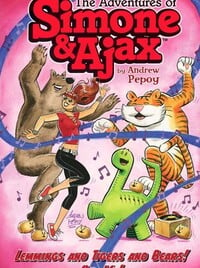
| |
| Author | Andrew Pepoy |
| Release date | 2022 |
| Genre | adventure, comedy |
| Pages | 128 |
| Available From | |
Greetings, readers! Welcome back to Graphic Novel Reviews! Today for our Very Special Issue 200, I will be taking a look at Simone and Ajax: Lemmings and Tigers and Bears, Oh My!
If you’ve read along with me for a while now, you might recognize the two stars of this tale, Simone and Ajax. I’ve covered them before, waaaay back in Issue 128, but now that there is a new book to review, I decided to save it for our Issue 200 celebration. Back in 2022, Andrew Pepoy put on a Kickstarter and Indiegogo campaign to raise the funds he needed to create another Simone and Ajax book, and late last year, those books were shipped out to backers. Recently this year, another campaign was created to raise the funds to clean up and re-release the first book in the series, a black and white collection that Andrew had created while he was in college and in the early parts of his career. I backed it to pick up the first book in the collection. I’m planning on reviewing it next year after those books ship out, so if you liked this review, watch out for that one in the future! I've actually had a chance to meet Andrew at our local comic-con for a couple years now, and he is absolutely lovely to talk to as well. He's got a lot of experience in the comic book industry and he's very excited to work on his own projects and connect with readers and fans. This year, he mentioned that he wanted to do a proper re-release of the second book (the one I covered back in 128), a new book based on another original character that he has worked on in the past, and in the future, a fourth Simone and Ajax book. Needless to say, I'm very excited to see more of his work, both returning characters and some new ones that I haven't read before as well, and you can look forward to those appearing in this comic as soon as they're released! Hopefully, he gets invited back to the 'con next year so he can give me some more recommendations on what to read next.
Let’s move to the book now. Volume 3 is comprised of four stories, one featuring a treasure hunt and pirates, one where Simone and Ajax travel to the Wild West, one where the two tangle with classic horror movie monsters, and one Maltese Falcon-esque parody story. My favorite of the four is probably the pirate story- Andrew’s gorgeous lineart is on point and on full display. Simone looks great in a floofy pirate’s outfit and Ajax gets a cute little pirate captain hat. Just like the last book, this one is also full of great fashions for Simone, and packed with silly and goofy jokes (although there was one in the Wild West story that I did raise an eyebrow at for being a little insensitive) for all ages. Older readers will enjoy the references to classic movies, and the lovely colors and linework will captivate readers of all ages. As usual, Simone gets a wide lineup of outfits, from the aforementioned pirate’s outfit to a cowgirl set to a closet full of slinky black dresses that evoke Morticia Addams’ style.
I honestly cannot recommend Simone and Ajax to you enough. It's a series that I really like, and I'm excited to explore more ground in the coming books. I would recommend that you pick up this book, as indie books can be a little hard to find after the first couple years they're released. If you grab books 1 and 3 right now, 2 will be on the way in the next couple of years, and BOOM, you've got a collection started. Simone and Ajax is one of my favorite series, and I hope you'll give it a try, too!
That's all for me this time, readers! Join me next time as I ring in the new year with a new Book Review!
A Digimon World Soliloquy
Hello, and welcome to a section that's been years in the making. As those of you who read Strategy Wing – or really people who know me in general – know, I'm a huge fan of the 1999 original PlayStation game Digimon World. It's probably my favorite game on a non-Nintendo system, and, honestly still in my top ten all-time game list even when counting Nintendo stuff. Digimon World is an odd game! I affectionately refer to it as "the best worst game of all time". It's a very confusing mishmash of poorly-explained game mechanics crossed with some of the most addicting gameplay I've ever played, so I decided, for Issue 200, it was finally time for a critical deep dive into one of my favorite games of all time.
Digimon World is unlike any game I've ever played (outside of the two direct sequels to Digimon World, of course). Digimon World is like a combination of an adventure game and virtual pet simulator. Something important to note is that, while in the west, Digimon World was released after the Digimon anime premier, in Japan, it was released three months prior to the anime's debut, so there are no elements from the anime that are really incorporated into Digimon Word. Because of this, Digimon World feels like an evolution of the Digimon virtual pet keychains, through which Digimon first gained popularity. The basic premise is that you, a human boy named Mameo, are sucked into the digital world by a Digimon named Jijimon. He tells you that the digital world is in trouble, with Digimon having left File City and a series of calamities happening. Giving you a partner Digimon (which is always either an Agumon or a Gabumon) based on a short survey you answer at the start of the game, he instructs you and your partner Digimon to explore the Island, to convince Digimon to rejoin File City, and to investigate the calamity that's affecting the Island and driving all the Digimon mad.
Core Loop: Not as Frustrating as it Sounds
The gameplay of Digimon World is very odd, but I think it's very addictive. You spend a lot of time not really progressing in the game, because you need to train your Digimon up in stats at the local gym. The game has six stats, and they're pretty standard adventure game/RPG stats, these being Offense, Defense, Speed, Brains, HP, MP. The only one that really needs explanation is the Brains stat, which we'll get into a little bit more when we talk about combat.
I think the core loop is very fun because it's basically "you train up a Digimon until it reaches champion level (so three in-game days), and then you explore File Island, finding various challenges to complete in order to convince Digimon to rejoin File City. The complication is that your Digimon can only last a max of like 21 days (without the use of life-boosting items like Chain Melons and Digiseabass). After that, they die and you start the process over with a fresh (baby) Digimon. That Digimon will have slightly higher stats based on your previous Digimon's stats and your tamer level, and it'll also remember any moves your previous Digimon learned. So the cycle is as follows: make your Digimon really strong, complete as much of the game as you can before it dies, and do it all over again.
This can be frustrating, especially when you have a really cool Digimon and it dies, but I find it to be quite enjoyable and it's not as bad as it sounds. Usually the absolute minimum a Digmon will live is 12 days, and you get your champion on day four. This means you can get quite a bit done with a single Digimon. For example, in my Strategy Wing section, I got almost half the game done with a single Digimon. On the flipside, I've also had runs where I got bogged down by subpar champions and just outright couldn't raise them strong enough to be able to compete against stronger Digimon.
Building a City is Pretty Cool!
Every Digimon you bring to File City serves a purpose, and I think File CIty itself is one of the coolest things in the game! The city grows as you bring Digimon in. New buildings like a hospital or a restaurant spring up, each staffed with Digimon that do something different. Take the ttem shop for example, where each Digimon that works there has a unique item only they sell. And there's even a schedule for when those Digimon will appear, so once you get that down, you can always guarantee you'll see your favorite shopkeep or restaurant chef. I think the coolest addition to the city is Drimogemon, a drilling Digimon. He carves out an entire cave and opens up a treasure hunting business! Not every Digimon has a useful purpose. Take Elecmon, who just sets up some street lights, or Ogremon and Bakemon, who "patrol" the city, supposedly looking out for shady characters. But even these useless Digimon bring a charming touch the city. As a kid, I was always excited to see what each Digimon did in the city. There's just something so cool about a city that grows and a system where each Digimon serves some sort of function.
Combat? Not Great!
There are a number of ways you can recruit Digimon, but the most common way is combat. The combat system for Digimon World is strange. You don't directly control your Digimon; instead, you shout commands at him and eventually he does them. It's a very odd system that is not great! A lot of the fights become overly frustrating when you Digimon just refuses to do anything and instead just runs around as you're screaming the attack command at it. This is where Brains comes into play. I don't think it operates in a great way though. A higher Brains stat gives you access to more command options, but it doesn't actually impact what a Digimon will do in battle, only what you can tell a Digmon to do. This results in there not being a ton of advantages to a higher Brains stat outside of more specific commands such as the ability to tell a Digimon what move to use. I think the battle system is more frustrating than it needs to be, since it's just so passive. You're literally yelling commands at your Digimon and hoping that he'll do them, and sometimes he just won't! He'd rather get punched in the face than throw a punch. This is especially bad in fights with more than one Digimon, because you can find yourself getting bodied as they keep throwing attacks at you before you can respond! So yeah, the combat? Not great!
Later fights against stronger champion and ultimate Digimon kind of just boil down to having enough healing items. Just keep healing your Digimon until they eventually outlast the opponent. Combat never really gets better, but at least some of the moves are really cool, coming with pretty slick animations. There's a pretty cool status affect that turns the Digimon into the sprite from one of the virtual pets and that's just real neat, too… but speaking of moves!
Move Learning? The Worst!
The move learning system in this game is the absolute worst move system in the history of video gaming! Each Digimon can learn moves based on their types, but, here's the thing, there's absolutely no way to know what moves your Digimon can learn without a guide! There is nowhere in the game that tells you "Greymon can learn X move," and it's not like it's as simple as "oh, every fire-type Digimon can learn every fire move", because, nope, that's not the case! Take Greymon for instance, who can only learn six of the eight fire moves.
That's not even getting into the fact that the way you learn moves in general is terrible. The way a Digimon learns a move, is if it sees a move in combat that it can learn, it can then learn that move based on a combination of the move's learn percentage change mixed with its typing. It's a very weird formula but I can give you a good example to better explain it. Greymon's primary type is fire, so it'll have the easiest time learning fire moves. The move with the best chance of actually being learned by Greymon is Spit Fire, with an astounding 30% chance to learn the move after a battle if the enemy uses it. But Spit Fire sucks, so, instead, let's look at one of the good fire moves, like, oh, say, Meltdown. The chance of Greymon learning Meltdown? 14%. And again, remember that, in-game, you have no way of knowing that Greymon can even learn Meltdown. I've had entire Digimon that never learned more than the basic move they start with (the weakest move of the type of your rookie), because the algorithm never decided to give me another move. It's an inexcusably bad system. It's probably the worst feature of the game.
The Atmosphere is a Big Plus
Okay, now time for some positives! I love File Island I think File Island is one of the best worlds in all of gaming. It's so weird, different, and varied. It's this great hodgepodge of electronics and nature. Trees are made of cables and the ground is littered with outlets. The floor of certain areas is made of circuitry. It's really leans into the fact that this is a digital world, and there are a ton of areas to explore, with varied environments from ranging from icy areas to a toy land. The game is constantly throwing new areas at you, and barring maybe one or two exceptions, they never overstay their welcome. I think one of the coolest areas thematically is the Ancient Dino Region. One half is the Glacial Time Zone. Here time moves at half speed and it's full of dinosaur-themed Digimon who simply want to relax. The other side of the Speedy Zone, where time moves at double speed. It's stated to be a dangerous area where crazed Digimon attack you. While I don't really like it from a gameplay standpoint, I love it from a thematic standpoint.
The music of Digimon World is top-notch as well. It does this interesting thing where a lot of the earliest areas don't have music, instead focusing on atmospheric sounds. For example, in the Drill Tunnel, instead of music, the sounds of drills drilling in the dirt is played because this is an area where Digimon are working. The Native Forest (the game's first area) has two "tracks". In the day, you can hear the sound of birds chirping, while at night you hear the sounds of crickets trying to get laid. But once you start getting out of the early areas, the music goes hard! The Ancient Dino Region's Speedy Zone theme is a dramatic organ-based affair, as if the music is warning you of the dangers. The Ancient Glacial Time Zone, on the other hand, is a strange mixture of a beating drum and xylophone, almost as if to tell you that you're in a strange new land. The Tropical Jungle features a track backed by bongos, with the sound of wild animals and xylophones accompanying them. Monochromon's shop, as evil and hate-filled as it is. features a track that sounds like elevator music, something that wouldn't be out of the ordinary for an actual shopping experience. I don't think there's a bad track in the game, and most of the tracks are split into day and night variants, with the night variants tending to be the livelier of the two. Each track is a banger and perfectly fits the area they play in. Honestly, the only problem is that, since the Jukebox doesn't work due to one of Digimon World's many glitches, the only way to hear any song in game is to be in that area.
Telling a Story And Doing it Well
Digimon World has maybe my favorite story development in any game. While on its face it's a pretty simple "calamity has happened, stop calamity" plot, the game is constantly going out of its way to show you how the calamity is affecting the island. The game not only tells you that Digimon used to be a civilized and have recently become more tribal in nature, forgetting their languages and splintering into uncivilized groups, but it also makes sure to show you that as well. It comes through one of the early bosses, Meremon, who has realized he's slowly losing his mind and, in his delirious state is trying to destroy the island through earthquakes, doing so in a half-forgotten attempt to make other Digimon realize what's at stake. It comes through an entire story arc with Ogremon, who, realizing something is going wrong, turns to crime in despair, thinking that nothing can save the island. The game is constantly using Digimon to show you what's at stake for the island. It's consistent storytelling that sucks you into the narrative. You want to help this island; you want to solve the mystery of what's happening and save File Island.
I genuinely adore the way that Digimon World drops its lore. I think the lore is very engaging and I think the way the game lays it out is so smart. You basically have three main lore givers. First, there's Cherrymon, this ancient tree Digimon who may be the oldest Digimon on the island, and who lives in the Misty Trees. He tells you the history of the island, and how, years ago, another continent sprung up. Slowly, Digimon began drifting apart, forgetting their common tongue, and forgetting they were once a single community. Even Cherrymon, the wise elder of the Digimon, is starting to be affected, and he has forgotten something very important that he meant to tell you. Next there are the Tinmon, who, after completing the Toy Town quest, "sing" you an old tale. One day, bad guys showed up on File Island, claiming the island for themselves and attempting to enslave the Digimon, but the Digimon united against them and chased them off the island. Yet the trouble was not over, and the bad guys swore they'd return someday. Finally, in Factory Town, which contains File Island's main data hub, you learn (after defeating a brainwashed Giromon and reporting to Andromon), you learn that, 100 years ago, humans arrived on the island, attempting to conquer it. It's the last of these humans that's causing all the problems. It's just such a good way to give out the lore. Unfortunately, because you do a lot of things in different orders, you can run into a situation where you do the Factory Town stuff before Toy Town, so the lore drops lose a little bit of luster since it's not guaranteed to come in sequential order. Even so, I still think it's a very satisfying narrative process.
One Glaring Flaw
Now, it's unfortunately time to talk about the biggest flaw in Digimon World, and that's that the game refuses to explain literally any of its mechanics to you. Being based primarily on the Digimon pet simulators, Digimon World has a lot of elements from those. A lot of the game is based around properly raising your Digimon in order for it to turn into stronger Digimon and for it to live longer, but the game gives you literally no indication whether or not you're doing things right. The only indications you're given are little thought bubbles that represent the Digimon's needs. Those are pretty self-explanatory. Feed it when it's hungry, take it to the bathroom when it needs to poop, etc. The problem is, that's barely scratching the surface of the many, many different care requirements.
There are so many features like weight, happiness, and discipline which the game just does not explain it at all. This hurts the player, because each Digivolution has certain requirements you need to meet in order to get them, but, in-game, there's literally nothing that will give you even the slightest hint on how to achieve a good Digivolution.And it's not just stats, either! There are a lot of different sub-requirements like care mistakes, move learning requirements, and battle requirements, and these go into which champion you'll get when your Digimon is fully grown and trained. Again, though, just playing the game, you're shooting in the dark! Like, I get where it comes from, because part of the magic of those old virtual pets was that you'd get different Digivolutions depending on what you did. But those didn't have stakes! If you got a Numemon, it didn't really matter. In this game, you can just end up fucked and have no idea why you got fucked. I don't think there's any reason a game needs to be this cryptic. Like, yes, you obviously don't need to give out all the info on how to get every form, but there should have been a middle ground where there was some sort of way to know if you were on the right track or not. I can totally see this being a turn-off, because, at the end of the day, it's very frustrating that you can be punished for mechanics the game just outright doesn't explain very well.
Digimon World is a very difficult game for me to look at objectively. For the better part of my life, from probably about the time I was seven or eight, I've been playing Digimon World on and off. It's genuinely one of my favorite games. So much about it is great. I think once you get it down, the gameplay loop is super fun. I love the way the story progresses, and I love exploring the different areas of File Island. But I can't overlook the fact that the combat basically boils down to throwing out healing items until you win, or that I've had loops where I couldn't raise my Digimon to be strong enough, so I couldn't accomplish anything. Finally, I can't overlook that fact that I'm in a unique position. I've been playing Digimon World on and off for twenty years. The fact that Digimon World doesn't explain literally anything to the player isn't a problem for me, because I already know enough to get by in the game. But I think it's a turn-off for new players. I think it's something that would intimidate most players as they try to complete a game without even the basics being explained in-game. Digimon World isn't a great game. Hell, I'm not even sure it's a good game. But it's a very unique experience, one that really can't be explained and one that has no real equal. It's a mishmash of poorly-explained ideas, cryptic nonsense, and frustrating design decisions, but still I love it. It's the best worst game I've ever played, so, with all that being said, my final score for Digimon World…
10/10
Character Review
Written by: Waluigi Time (talk)
Hello there, 'Shroom readers! It's been over two years since I was last here in Critic Corner, and now seemed like as good a time as any to drop another Character Review. Pushing the boundaries of what's really considered a character for this section, today I'm going to be talking about the Warden from Minecraft, one of the game's most unique mobs.
Unlike other mobs, the Warden is blind and relies on other senses. Most of the things that players or mobs do that make a sound cause vibrations that can be picked up by sensors in the Deep Dark cave biome, which can eventually cause the Warden to spawn if they're close enough to sculk shrieker blocks. (Unfortunately, this only works for naturally generated shriekers, so you can't take them and spawn a Warden in your friend's house as a prank.) The Warden itself will then listen for these vibrations to track down nearby players and mobs to attack, but the neat thing is that you can also distract it by doing things like throwing snowballs or creating noisy redstone contraptions. There's also ways to avoid causing vibrations, like sneaking or walking on wool. This is my favorite aspect of the Warden, it's a really neat concept to not only have a mob using senses other than sight, but also to have a mob that reacts to sound at all. It can also detect entities through touch and smell, the latter of which I'll get back to in a little bit.
The Warden is more of a force of nature to be avoided at all costs rather than an enemy or boss to fight. In melee combat, it can outdamage almost any mob in the game, the only potential exceptions being explosions caused by Creepers or the Wither's initial spawn depending on proximity. Its ranged attack, while beaten by damage from several other mobs, is still one of the most powerful in the game. It also has more health than almost any mob in the game, beaten only by the Wither on the Bedrock version when set to hard difficulty. It makes sense that the Warden is powerful, otherwise there's not really a point to trying to be stealthy around it. Unfortunately, I think Mojang went a little too far in this direction, overshadowing the Warden's blindness in the end product.
Here's the thing, you can't please everyone all the time, especially when you have a fanbase as big as Minecraft does. Several of the design choices for the Warden, I believe, were even a direct response to player feedback during development that it was too easy. While I would have preferred if the Warden was designed mainly as a blind mob and then its power level was designed around that, that's just personal preference. I can't blame the developers or players for wanting the Warden to mainly be an overpowered monster instead, and while I dislike some of the design choices, I don't think Mojang was necessarily wrong for making them. Opinions are funny like that.
One of the two big problems I have with the Warden is its ranged attack. It's a sonic boom that it uses whenever it detects that it can't physically reach its target. While it doesn't deal as much damage as the Warden's melee attack, it passes through blocks, is impossible to dodge, and bypasses all forms of damage reduction except for the Resistance buff. I get the idea that they want it to be hard to escape, but an unavoidable attack that ignores blocks just feels like a very cheap implementation. The Warden is already pretty fast, and it would've been a lot cooler if they gave it additional ways to chase you down. Imagine if it could climb blocks, squeeze through small holes, or even burrow through blocks like it does when it spawns in pursuit of targets! Mojang even dabbled with some of these - an earlier iteration of the Warden had the ability to assume a one block tall form, while the burrowing idea was suggested but was considered too difficult to implement.
The other big problem, which makes the first one worse, is the Warden's sense of smell. Even though it can't see them, the Warden is constantly "aware" of all entities within about 25 blocks of itself in each direction, and when there aren't any vibrations to investigate, it starts sniffing them out while pathfinding towards them. Eventually, it becomes hostile and attacks the target. I really don't like this, and to me, it's just undercutting the Warden's blindness. Unlike the vibrations, scent isn't really an actual mechanic. There's no way to interact with it at all, it just allows the Warden to find nearby entities. Depending on how you look at it, this actually makes the Warden more powerful than if it could see. Its detection range is higher than the line of sight for a lot of mobs, it can smell through blocks, and thanks to its sonic boom, it can still attack anything in range. Say you have two separate sealed boxes, one has the Warden and the other has any other entity. Even without a single vibration, the Warden will eventually get mad and kill the entity in the other box.
So that's the Warden, a neat concept that, in my opinion, is unfortunately overshadowed by the design philosophy of making an extremely powerful mob. But hey, that's just my take on it. Maybe you read all of this and you think the Warden fills its niche perfectly well. Or maybe you disagree with me and still don't like how the Warden was designed! It's all about what you want out of it.
Van Shoeul's House of Ghouls
By: Vincent Van Shoeul (talk)
| Witchfinder General | |
|---|---|
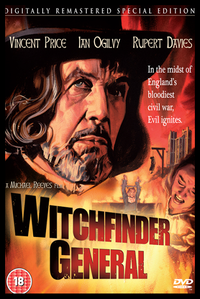
| |
| Genres | Horror |
| Release date | 1968 |
| Starring | Vincent Price, Ian Ogilvy |
| Directed By | Michael Reeves |
| Runtime | 86 minutes |
| Streaming | Youtube, Pluto |
Good evening, and welcome to another Van Shoeul's House of Ghouls. As always, I'm your guide through the darkness, Vincent Van Shoeul. Last month, we looked at the zanier style of horror as Jason Voorhees took on a girl with psychic powers. For this month's picture, we return to our comfort zone with a film from the 1960s, made by American International Pictures, and starring the one and only Vincent Price. For this month's picture, we have Witchfinder General, or, as it's known in the United States, The Conqueror Worm. This film, however, is unlike any Vincent Price film we've looked at. It's a (for the time) graphic affair of cold-blooded torture, blood, violence, and witches. For those of you who shiver at the sight of blood, I implore you to skip to the next review, but for you brave enough to stay, I can promise you this will be a thriller!
For this month's featured performers, we have, first Robert Russell as John Stearne, Matthew Hopkin's chief torturer, a sadistic man in charge of getting people to confess to witchcraft. We also have Rupert Davies as John Lowes, a priest who has the unfortunate luck to be accused of witchcraft. Hilary Dwyer stars as Sara Lowes, niece to John Lowes and fiancé of Richard Marshall and a nice girl who finds herself the victim of Matthew Hopkin's affections. There is Ian Ogilvy as Richard Marshall, a soldier in the Roundhead army who vows revenge after the treatment of his fiancé and fiancé's uncle by the witchfinder. Finally, we have section mainstay Vincent Price as Matthew Hopkins, a witchfinder by trade who roams the lands of England exterminating "witches".
Produced by who else but American International Pictures, Witchfinder General had a very troubled production. The film's production was marred by the feud between director Michael Reeves and film star Vincent Price. Michael Reeves never wanted Vincent Price, and told Vincent Price as much directly during the filming. All the while, Vincent Price, assuming that this was just another standard fun little horror film like those he'd become accustomed to starting in, never actually read the script before accepting the part and found himself shocked by the violence. The feud continued throughout the film, with Vincent Price feeling that Michael Reeves gave unclear direction and finding himself frustrated throughout the film. Michael Reeves, for his part, wanted to prevent Vincent Price from hamming it up in this film. One notable moment of the feud was Vincent Price confronting Michael Reeves, telling him that he had made 84 films and asking what Michael Reeves had done, to which Michael Reeves responded by telling Vincent Price that he made 3 good ones!
Set during the English Civil War between the royalist supporters of King Charles I of England and the Roundhead supporters of Oliver Cromwell, Witchfinder General is a fictional piece about the Witchfinder General Matthew Hopkins (Vincent Price) and his "assistant" John Stearne (Robert Russell). The two of them have been taking advantage of the chaos caused by the war to roam the countryside, getting people to confess to witchcraft. One day, their work happens to take them to Brandeston, where the town's priest, John Lowes, has been accused of witchcraft. Fearing trouble is brewing during this war, John Lowes grants a Roundhead soldier, Richard Marshall (Ian Ogilvy), permission to marry his niece Sara (Hilary Dwyer) on the condition that he take her away. Richard agrees, but, before he can follow through, Hopkins and Stearne arrive and begin prescribing the legal methods to make him confess to witchcraft.
These legal methods include, of course, stabbing him with a rod to find the devil's mark, a spot on the body the devil imprints on the body that can feel no pain (why the devil would put this there is never explained), torturing him by making him run around a table until he confesses, and, of course, beating him. Sara offers to have sex with Hopkins if she allows John to live out the rest of his life in a prison instead of being tortured and executed, and Hopkins agrees, but Stearne finds out about this relationship, and, when Hopkins goes off to investigate claims of witchcraft in another town, he corners and rapes Sara. Hearing of this, Hopkins becomes enraged (I think it's supposed to be implied that Hopkins thinks they had consensual sex) and calls off his deal with Sara, allowing Stearne to torture the priest. Then, when the priest still refuses to confess, Hopkins has him executed anyways! When Richard returns to the town and finds out about both the rape and the priest murder, he vows revenge and vows to kill Hopkins and Stearne. That's a basic summery of the plot setup, and I'll go over any other details as need be.
The movie is, for the time of its release, very brutal. It censors nothing and goes out of its way to show the brutality of the time period in which the film is set. The measures prescribed by law to get people to confess are nothing short of torture, with such elements as stabbing suspects repeatedly to find the nonexistent devil's mark. The interrogation of John Lowes and an unnamed female suspect just consist of Stearne beating them repeatedly until they confess. The executions in the film leave nothing to the imagination, either, and only get more brutal as the film goes.
The executions start out "tame" enough, with a screaming "witch" woman being dragged to the gallows to be hung, but the next is the infamous swim test, which I believe was based on something Matthew Hopkins did in real life. Basically, they take John Lowes and two unnamed suspects and tie them to a rope. They then throw them into water with the idea being that, if they drown, that means their confessions were false and they weren't really witches, but, if they struggle, that means the devil is keeping them alive and they are to be pulled out and hung as witches… because, you know, logic or whatever. I think the final execution scene is the most brutal though. Hopkins has invented a new way to execute witches. He lights a pyre on fire and has a confessed and bloody woman named Elizibeth dragged out. He then has her tied to a separate pyre and lowered into the fire as she screams in agony as her husband is forced to watch.
What makes it even more fucked is that this is only the first of three witches Hopkins intends to have killed this way (although the other two do only happen offscreen). The film doesn't shy away from violence and, while the gore doesn't really compare to the buckets of blood films of the 80s-through-today put out, it's a lot violence from a film of this era, and it's not unnecessary, either. It's all used to show how sadistic Stearne and Hopkins are.
Both villains are very dark characters with no real redeemable qualities. Of the two, Stearne is the more openly cruel. Hopkins' chief interrogator (torture master), Stearne openly enjoys torturing people and is a real bully who delights in drinking, whoring, and beatings.
Openly disappointed when Hopkins doesn't allow him to torture the priest, he pursues and rapes Sara once he finds out her and Hopkins are having sex, and does so out of pure sadism. But while he's strong when he has the advantage, he's weak when facing a threat head on. Multiple times, he finds himself humiliated by characters. The first is when he unknowingly introduces himself to Richard, who had ridden off (abandoning his post) looking for Hopkins and Stearne. Richard then beats the absolute shit out of him, and the only reason Stearne escapes is because the bartender intervenes, knocking out Richard and allowing Stearne to flee. Stearne then gets a double whammy of humiliation from Hopkins, who first abandons Stearne to be pressed into the armed forces after they're harassed by some of Cromwell's men, and then when he (after escaping the soldiers) confronts Hopkins in Lavenham. Hopkins just outright pulls a gun on him and forces him to get back to being his partner. He's the classic henchman character, bullying the weak, but immediately put back in his place when facing the heroes or his boss.
Matthew Hopkins might be the most evil character Vincent Price has ever played, and it's just so different from how he usually is. Usually, he's the over-the-top, delightfully evil villain, the kind of character the audience falls in love with as they're charmed by his wicked deeds. Not here though! In this, film Vincent Price plays a much darker role. Instead of a charming, almost sympathetic villain, we have a truly nasty and evil character. Matthew Hopkins claims to be only doing his duty in weeding out witches and to always follow the law, and, while Hopkins expresses disgust at his partner's love of torture, it's clear that Hopkins truly loves the torture just as much as Stearne does. Hopkins truly cares little about anybody else. He easily abandons his partner and leaves him to the Roundheads. He, without remorse, goes against his deal with Sara after finding out she was raped by Stearne. A disloyal, hypocritical man who thinks nothing of others, hiding it only under a thin veneer of claiming he's doing the work of God and eliminating evil, that's Hopkins. Nowhere is this clearer than in the way that he keeps inventing new ways to torture these alleged witches. From the swim test to burning them alive, he thinks nothing of violating the law when it suits him, including executing a woman who claims to be with child, whose execution is a stated violation of the laws of the land. He goes after an innocent Sara just to get Richard to confess to witchcraft because it would make his life easier, even though, as Stearne points out, they already had the money from the town and they could have easily just cut and run.A self-important man who truly believes nothing bad can happen to him, this is the darkest character in Vincent Price's catalog, and Vincent Price knocks it out of the park! While Vincent Price was mostly known for playing sillier B-movie style characters, roles like this show that he could have easily adapted to any horror format, because his performance as Matthew Hopkins is some of his best work and really shows his range as a horror actor!
Unfortunately, our heroes are kind of nothing characters, especially Sara because she just plays such a passive character. She starts off sort of strong, being an openly sex positive character who has premarital sex with her fiancé Richard. She is also smart enough to not only lie about being John Lowes biological niece to ward off Hopkins of suspecting her of witchcraft, but also to use her body to convince Hopkins to spare the priest. But after she gets raped, she basically fades into the background, playing the role of the terrified damsel character. One scene that really bothers me is she flees to another town and then Hopkins ends up in that town hunting for witches. Well, she knows he's there, because she watched him execute three other witches, so what does she do? She strolls around town and ends up being seen by Hopkins and Stearne, which snowballs us into our ending. Why would you do this if you know the two witchhunters your fiancé has vowed revenge on are here?
Richard, I would say, is the better character, because he's more fleshed out. A gallant and noble soldier in the Roundhead army, Richard is determined to avenge his fiancés honor by killing Hopkins and Stearne. Richard is really portrayed as an ideal soldier, a good fighter, and a crack shot, saving the life of his commander, who in turn spares his life after Richard deserts the army the first time. Unfortunately, he's kind of one-note. He's just the hero who is determined to be defeat the bad guys. While he's more active than Sara and actually fights both Hopkins and Stearne, he suffers from the same problem everyone who faces off against Vincent Price does; they aren't Vincent Price and Vincent Price is always the star and the most interesting character. Against Price, the heroes tend to be kind of bleh, and, sadly, this film is no exception.
The ending of the film is really really good, and wasn't originally supposed to be this good, actually. So, to set the scene, Hopkins and Stearne are in Lavenham, executing witches. Sara is in Lavenham because that's where she went into hiding after the events earlier in the film. At the same time, Richard has been sent, along with some soldiers of his own choice, to a nearby village because King Charles has been spotted there (don't worry, he had already escaped the village). He happens to hear that they're hanging witches in Lavenham from a local, so he rides off to pursue Hopkins and Stearne. Unfortunately for him and Sara, Hopkins and Stearne conclude that he will probably arrive in town. Stearne wants to run, but Hopkins decides that, since he has so much clout and since they believe Richard will pursue them forever, the optimal move is to accuse Richard and Sara of being witches and have them executed for witchcraft, thus ridding themselves of their problem once and for all.
Using their connections with the local magistrate, they arrest Richard and Sara and have them dragged to the local castle. There, Hopkins has Richard tied up and forced to watch as he tortures Sara, telling him it can all be over if he just confesses to witchcraft while Richard just repeats that he will kill them.
Unfortunately for Hopkins and Stearne, before they left with Richard and Sara, one of the soldiers under Richard's command spotted them. Hopkins shot him, but failed to make sure this killed him, and he's able to tell the other soldiers that Hopkins took Richard and Sara to the castle. As this happens, Hopkins decides to press a hot iron on Sara's back, telling her that, if she passes out, that means Satan has obviously intervened and let her pass out to spare the agony. The crazy part is this isn't even that farfetched! This is kind of how they got people to confess to witchcraft back then! How did nobody just shoot this guy in the head in real life? Anyways, before this can happen, the soldiers arrive and begin fighting their way to the torture room. Hopkins tells Stearne to cut down Richard so he can see his wife wither in agony. This is a stupid plan, and Richard escapes his bindings, stabbing Stearne in the eye and attacking Hopkins with an axe. The axe doesn't, like, cut Hopkins, by the way… which… I'm not an expert on axes, but do they work like hammers? Because bashing people is what a hammer does! Vincent Price really takes a beating, by the way. Apparently, he showed up drunk on set for this part and, as punishment, the director told Ian Ogilvy to really lay into Vincent Price with the prop axe.
So, now, I mentioned that the ending changed a bit. Well, the original ending was going to have the soldiers make it into the chamber while Richard was beating Hopkins, and, with two flintlock pistols, the soldiers would shoot both Hopkins and Richard. Well, when they went to film it, they realized they only had one flintlock pistol because the other one was dropped in an earlier scene. Not having time to reshoot that scene, director Michael Reeves improvised a new ending. In this new ending, the soldier shoots only Hopkins. This causes Richard to scream at the soldier "YOU TOOK HIM FROM ME!" as Sara screams on in despair. It's a really great ending. You get to see the evil villain get his ultimate comeuppance, but our heroes are now permanently broken. It's a such a great ending and it's amazing it was made on the fly.
Witchfinder General is a very good film and probably the best "horror" film Vincent Price was ever in. A very graphic film for the time that's not afraid to show its torture scenes, Witchfinder General is very easy recommend, being one of the best films of its era and made by a director who really knew what he was doing. Add in those very surprising-for-the-times displays of graphic violence, then pepper in one of Vincent Price's greatest performances, and you've got a truly classic horror film.
And so concludes this month's little tale. The moral of this story? I think it's fairly clear. "If you end up in 1600s England, try not to get accused of witchcraft, for they have the dumbest legal system for that". With that, our tale is finally at end. As always, I've been youre guide through darkness, Vincent Van Shoeul, inviting you to join me next time as I take a look at another film of terror.
Character Comparison
Written by: Hooded Pitohui (talk)
Even if you know next to nothing about the Pikmin series and its eponymous little plant creatures, there's a good chance that you at least know that Pikmin come in different colors, and that those colors have different elemental resistances. You might not know that Red Pikmin have extra attack power compared to most other Pikmin types (you could, though, by reading The Anatomy of a Pikmin in Strategy Wing), but there's a good chance you've picked up that they're immune to fire. You may be unaware that Yellow Pikmin fly higher than other types and dig faster than most other types, but you may well know they're immune to electricity. That color coding system makes it relatively easy to pick up on. Blue Pikmin can't drown in water. Ice Pikmin, to nobody's surprise, can't be frozen. There are a few other examples that aren't quite as obvious, too. White Pikmin resist poison gas and toxic spores, and Rock Pikmin can't be crushed (in most circumstances). These connections between the Pikmin and what they resist may not be as immediately apparent, but, the point is, they still fit the pattern; survey the different Pikmin types, and you realize that most Pikmin types have a particular hazard that poses no threat to them.
Once you know this system, it's not exactly a huge leap in logic to ask "well, what if there were a Pikmin type that, instead of resisting one hazard, resisted all of them?". Now, of course, as a young kid, that probably sounds awesome, while someone older is likely to dismiss that as potentially game-breaking, without some major limitations. After all, if one Pikmin type could resist all hazards, why would a player ever need to or even want to use the other types? The thing is, though, that Pikmin with resistance to most of the series' hazards do exist (and, luckily for all of us, the developers were wise enough to put some major limitations on them). In fact, there are two types of Pikmin with multiple resistances, those being the Bulbmin of Pikmin 2 and the Glow Pikmin of Pikmin 4.
Now, it's a fairly notable thing that Bulbmin didn't return in Pikmin 4, getting the boot in favor of Glow Pikmin, because every other Pikmin type returned in the game's main campaign, which makes it fairly clear that Glow Pikmin were a "take two" on filling the gameplay niche that Bulbmin filled two games prior. Bulbmin were straight-up replaced, and it's that which leads us to today. If you're going to replace a Pikmin type with another, it seems natural to ask if that replacement is actually better, or if maybe it's missing something that elevates the original. In light of that, today, we're going to put Bulbmin and Glow Pikmin head-to-head, directly comparing them in three categories to find out which multi-resistance Pikmin type is superior! Let's get underway!
Design and Appearance
The first point on which I'll compare these two Pikmin types is their design, what they actually look like. Looking at the Bulbmin, I can't exactly award it points for creativity. It's a small Bulborb with a Pikmin stem, and that's about it. They did make a change to the eyes, recoloring the iris from the normal blue of a Bulborb to entirely black, but that's a change that's difficult to even notice. I can't help but feel like they missed an opportunity to do something akin to Paras evolving into Parasect by recoloring the entire eye to be white (or even recoloring the entire thing, sclerae included, to black). It would have been more noticeable and have better conveyed a loss of the Bulborb's identity.
Other than that slight change to the eyes, the only other change to the Bulborb design is the addition of the stem, which is a simple reddish-orange color that blends in with the Bulborb body, and the characteristic Pikmin leaf/bud/flower, which glows a soft green when a Bulbmin is idle. In every other case, this soft glow matches the color of the Pikmin, and I've seen comments to the effect that they should have made the stem green, too, and really implied there's some green Pikmin type with an angle of being parasitic, though, personally, I disagree. I think it would just look odd, with too abrupt a color change from the Bulborb's back to the stem, and wouldn't stand out well against the leaf (which is what you'll see most of the time, since all Bulbmin are in the leaf stage by default and only advance to the bud and flower stages in special circumstances). When a Bulbmin does sprout a flower, it's a white flower identical to those of reds, blues, and yellows. That's fine, I suppose. It could have been pink to match the flowers of purples and whites (all Pikmin introduced in the same game, other than Bulbmin, share a flower color, with each game introducing a new flower color), but it's not a big deal, since white petals do make some sense for a species dwelling underground.
There isn't an inherent issue with Bulbmin having such an unremarkable flower, but it does become a point where Glow Pikmin outdo them. Like their fellow Pikmin 4 arrivals, the Ice Pikmin, Glow Pikmin have a yellow flower, but while Ice Pikmin have the same rounded petals all other Pikmin types have, Glow Pikmin distinguish themselves with notably pointed petals. It's a small detail, but one I appreciate as a means of signaling that, as much as they resemble other Pikmin, Glow Pikmin are a class of their own, with some strange characteristics. A small touch like that could have been a nice way to separate the Bulbmin, with their vastly different parasitic lifestyle, from other Pikmin types, too.
Glow Pikmin go further than flowers when it comes to setting themselves apart from other Pikmin types, though. The eschew a part of the traditional Pikmin body plan (even Winged Pikmin have little legs) by foregoing legs in favor of a wispy ghost tail. They have disproportionate heads compared to the typical Pikmin, comparable only to Winged Pikmin in this regard. On Winged Pikmin, though, it looks more... natural, helping to further sell their "flying insect" look by giving them a defined head and thorax, while with Glow Pikmin, it seems more like it is intentionally making them look odd. Finally, there is their mismatched eyes, something no other Pikmin type has. All of this put together makes Glow Pikmin look markedly unnatural, if still a little cute, and that works well, because, as we'll discuss more later, Glow Pikmin are supposed to feel unnatural.
All of that said, I'll be honest and admit that I still think Bulbmin are cuter. While I do think they missed some opportunities with them, just as a matter of personal preference, it doesn't change that I find them adorable. Putting that aside, though, I have to give the edge to Glow Pikmin when it comes to design. They have a bit more creativity packed in and a stronger concept underlying their designs.
Concept and Worldbuilding
One of the things I most like about the Pikmin series is that it goes out of its way to explain the biology and ecology of PNF-404 and the creatures that inhabit it, with the explorers and castaways throughout the series writing up notes on all the exotic creatures they encounter. The Pikmin themselves are a part of the ecology of their planet, and while many questions remain unanswered about their nature and their relationship to flora like Candypop Buds, we do know a bit about how they fit into this alien world. That's why, for me, it's important to evaluate a Pikmin type conceptually, to ask "how does this creature fit into the world of PNF-404 and expand the series' worldbuilding?".
The concept behind Bulbmin is a simple yet effective one. Simply put, Bulbmin are parasitic Pikmin. It's actually a neat concept, especially when you factor in that Bulbmin are exclusively found in caves. Pikmin propagate in large numbers on the surface, but their populations in caves seems to be more limited. Now, one reason for this is that caves tend to be refuges for larger, more dangerous predators, but one might presume that, as part-plant beings, Pikmin do better in some degree of sunlight, or at least the Onions that propagate them do. So if a Pikmin population were to end up underground, forced to propagate down there, one can imagine the Pikmin eventually evolving a parasitic lifestyle; the Pikmin may not be able to get nutrients and protect themselves, but a larger creature like a Bulborb can, so if they can commandeer one, they have an advantage. It's an ecological niche that makes sense, and grounds Bulbmin within the world of Pikmin.
Glow Pikmin, likewise, have a simple premise, though I don't think it's as an effective one. Glow Pikmin seem to be rooted in the concept of, to put it colloquially, "oooh, a ghooooost". What we know about Glow Pikmin is that they only appear at night or in caves, that they're produced by a termite mound-like structure known as a Lumiknoll, that (just as Pikmin do for an Onion) they protect the Lumiknoll and gather resources for it, and that (again, as Pikmin do) they work in groups and possess leaves that mature to buds and flowers. Given these similarities, characters in the series do classify them as Pikmin, though they also express doubt that they're truly Pikmin. In daylight, they turn into Glow Seeds, going dormant, and, strikingly, they don't show any signs of life and merely become photons that reconstitute themselves at a Lumiknoll when they die.
We're left with a lot of mysteries. What are Glow Pikmin, really? Are they governed by evolutionary processes? If they're merely reconstituted from light and don't truly die, why does the Lumiknoll need more of them? Why does the Lumiknoll make Glow Sap and how does it relate to the Glow Pikmin? Again, Glow Pikmin are seemingly designed to be unnatural, and I think that works to their detriment here. They don't feel like a real part of the world. Though they exist within it and interact with it, it feels like their existence is detached from the ecology of the world, and, at the end of the day, I just don't think they're as interesting as Bulbmin, as a result.
Gameplay Function
The final point on which I want to compare Glow Pikmin and Bulbmin is their function in gameplay, how well they're actually utilized in their games. Now, I have to note that Glow Pikmin get to appear in a gameplay mode - Night Expeditions - where they function somewhat differently than they function during daytime cave exploration. While this is interesting and does result in them having some unique abilities and properties, I can't really factor this in when comparing them to Bulbmin. That's a gameplay mode that didn't exist whatsoever when Bulbmin were in the series, after all. Where I can compare the two Pikmin types is in daytime cave exploration, as the fundamentals are the same in Pikmin 2 and Pikmin 4 and... well, caves are the only place Bulbmin and Glow Pikmin can appear and be used during the day.
So, let's talk about where Bulbmin are found and how they function. On certain floors of certain caves, an adult Bulbmin will spawn when you enter the floor. This always happens, and the adult Bulbmin poses a risk to your Pikmin, being able to eat them. If you have fewer than 100 Pikmin with you when you enter the floor, juvenile Bulbmin will spawn with the adult and will follow it until the adult is defeated. If you have 90 or fewer Pikmin, then 10 juvenile Bulbmin will spawn, and if you have 91 or more, the number of juvenile Bulbmin spawned will be reduced such that your Pikmin count plus the number of juvenile Bulbmin sum to 100. Once you defeat the adult, the juvenile Bulbmin following it will enter a panicked state and begin running around, but by calling them with your whistle, you can bring them under your command.
Once under your command, Bulbmin can be used as you see fit, functioning like any other Pikmin type. They have average attack power and average speed, but, notably, resist every elemental hazard (poison, water, fire, and electricity), only dying to hazards that equally affect all Pikmin like explosions, crushing, and being eaten. There is, however, one caveat on their use. To prevent you from amassing an army of Bulbmin, you cannot take them out of the cave in which they are found. When you leave the cave, any Bulbmin with you are left behind; though, thankfully, most caves with Bulbmin have Candypop Buds which allow you to convert Bulbmin to another Pikmin type before you leave.
On the whole, this makes Bulbmin useful while putting reasonable limits on them that prevent them from being overpowered. This system does have a few flaws, though. First and foremost, it heavily restricts where you can use Bulbmin. Pikmin 2 contains fourteen caves, and Bulbmin appear in a whopping... three of them (they also appear in two challenge mode stages). This makes Bulbmin fairly situational. Even worse, due to the way their spawning is limited by the number of Pikmin you have with you, if you enter these caves with a large squad and are good at preserving your Pikmin, there may be only a couple of Bulbmin for you to collect (or even none at all)! This makes them even rarer and more situational. You just don't get much of a chance to play with them and use them for much, you know?
The final problem with this system is a minor one, but it also keeps Bulbmin from reaching their full potential. Pikmin have three levels of maturity, represented by them having a lead, bud, or flower on their head. Pikmin with a higher maturity level are faster and, thus, more useful. To grow in maturity level, a Pikmin either has to be left buried in the ground for two minutes or needs to drink nectar to go immediately to the flower stage (there are a few other niche methods, like being buried by a Mamuta, but set those aside for now). Can you see where this is going? Since Bulbmin always start in leaf stage and unburied, they can't mature without sipping up nectar better saved for Pikmin you can take out of the cave with you, outside of some rare cases where an enemy can plant them for you. This means that Bulbmin will, most of the time, be lagging behind your other Pikmin and won't be a great choice for carrying treasures for you.
What does Pikmin 4 and its Glow Pikmin do differently? Instead of being encountered in the wild in caves, you have to actively summon Glow Pikmin to your side (while within a cave) by using Glow Seeds. You obtain Glow Seeds by completing night expeditions, with every five Glow Pikmin remaining in your squad at the end of the expedition translating to one Glow Seed (rounded up). Once in a cave and in possession of fewer than 100 Pikmin, you can use as many Glow Seeds as you would like until your total Pikmin count reaches 100 (or until you run out of Glow Seeds, naturally). Glow Seeds do not get buried in the ground, so you immediately get Glow Pikmin in the leaf stage. Once you have them, you can command Glow Pikmin as you see fit, and, like Bulbmin, they are immune to fire, poison, ice, electricity, and water while still being vulnerable to all-Pikmin hazards like explosions, crushing, and Gloom. Like Bulbmin, they have average attack power and speed. Also just like Bulbmin, they can't be taken out of the cave in which you spawn them, but can be converted into other Pikmin types using Candypop Buds.
Now, you might think that this doesn't sound too different from Bulbmin and, as a result, doesn't solve the problems their system had. It does in fact, however, address all of the problems the old system had. Since you can summon them as you see fit, Glow Pikmin can be used in any cave in the game, rendering them far less situational than Bulbmin, Furthermore, because the Glow Pikmin do not exist until you use the Glow Seeds, you do not have to worry about them being prevented from spawning if you have a large Pikmin squad. This is actually a fairly large boost. In Pikmin 2, if you passed the sublevel Bulbmin were on and had a full Pikmin squad, but then lost a bunch of Pikmin on the next floor, well, you were out of luck; you couldn't go back up a floor to find the Bulbmin again and top off your squad. In Pikmin 4, you can call Glow Pikmin forth as you need them, without ever having to worry about accidentally passing them up.
Now, keen readers have likely identified one area which was not improved. Since Glow Pikmin start out in the leaf stage and start out unburied, they, like Bulbmin, must have trouble maturing, right? No, they do not have trouble, because this was addressed, too! Unlike all other Pikmin types, Glow Pikmin mature based on the amount of time they've been out of the ground, so Glow Pikmin will slowly mature as you explore despite them starting unburied.
To get right down to it, in every way possible, Glow Pikmin are an improvement on Bulbmin in terms of their role and function in gameplay.
And the Winner is...
At the end of this head-to-head comparison, with Glow Pikmin taking two of the categories I chose to evaluate them and Bulbmin on, would I say that Glow Pikmin are unequivocally better than Bulbmin? I... wouldn't, actually. I like Bulbmin a lot, and I put a lot of weight in them feeling like a natural part of the Pikmin world. What I would say, though, is that Glow Pikmin are worthy replacements, doing everything Bulbmin did while refining their gameplay niche. While I have a soft spot for Bulbmin, I have to concede that Glow Pikmin did the job better here, and it was the right call to push Bulbmin aside to make room for them.
Who knows, though. Maybe Bulbmin will return once again someday with some retooling to make them more distinct from Glow Pikmin and to give them a new niche. I wouldn't mind that! For now, though, well, Glow Pikmin have their role wrapped up pretty well, and I can't see Bulbmin returning unchanged.
12 Months of Mario - From Worst to Best
Hey everyone, it’s GPM1000 here! Before I say anything, I just want to say… wow. Issue 200. It really warms my heart to see something that has been such a constant part of my life for so long reach such an important, major milestone. There was a year or so where I was very on and off with regard to my contribution to The ‘Shroom, but it has been something I have actively contributed to for the better part of five years if I am doing my math correctly. Even before I wrote for The ‘Shroom, I would just scroll through it and read it, hoping that one day I would get to work on it myself.
This meant that it felt like an incredible honor when I was asked to write a special article just for issue 200. I have always looked up to The ‘Shroom and its contributors, and it is a wonderful feeling knowing that I get to work alongside some of the smartest and most interesting people on the Internet. Because I have participated in this community for such a long time, I definitely plan on writing a broader variety of articles in the future. However, it’s hard to deny the elephant in the room: I’m the Mario Calendar guy.
I’m honestly not sure what it is, but there’s just something I love about Mario Calendar. I love working with data and organizing it, and that might be part of it, but I think the main thing is that I love Mario. This is a franchise that has meant so much to me since I first learned about it all the way back in Kindergarten, and getting to immerse myself in the history and lore of the franchise that I hold so dear is something very special. I want to thank everyone that contributes to The ‘Shroom and that reads The ‘Shroom, as getting to participate in it and add to something that is so cared for by so many people is truly a wonderful feeling.
Anyways, as you can probably imagine, I know a lot about the months of the year and how they relate to the Mario franchise. One would hope so, as I have significantly immersed myself in this world for quite some time now. Therefore, for issue 200, I thought it would be a lot of fun to take a look back at all of the months of the year and see how they stack up against each other. There are so, so many Mario games that have come out in every month of the year, but that does not mean that all months are created equal. In fact, I would say it is very much the opposite—there are some months that have truly stood out to me over the years, and some that have left me wondering why they feel so lacking.
So that’s what we’re going to look at today! Let’s take a look at all twelve months of the year and see which ones are the best of the best, and which ones leave something to be desired. And remember, this is my opinion.
Also, a note to keep in mind before we get started: I will almost entirely be basing this on the Japanese releases of games. I am most interested in the games that actually came out in each month of the year and, for older games, that usually means Japan got it a little earlier than other places in the world.
12. March
Honestly, there’s just not much to say about March. It makes sense that there weren’t a ton of heavy hitters during this time of the year, as there’s nothing particularly special about it from a marketing perspective. It’s not during summer in the northern hemisphere, which means that children don’t have a lot of time to play video games, and it’s not close to any holiday or gift-purchasing occasion. This is a trend you’ll see for most of the lower months on the list.
In terms of games that game out, there just really isn’t much to speak of. However, that doesn’t mean it was completely empty. Super Mario RPG: Legend of the Seven Stars was a March release, and that is an absolutely fantastic game. It was also a pretty good month for spin-off titles, such as Luigi’s Mansion: Dark Moon and Yoshi’s Crafted World. Like I said, it isn’t completely empty, but certainly not one of the more notable ones.
11. February
This month just barely edges out March for me, and that’s for a singular reason: Mario & Luigi: Bowser’s Inside Story. I have so much nostalgia for this game from playing it when I was a kid, and it’s probably my favorite Mario RPG, if I have to choose. I certainly believe it beats out Super Mario RPG, so that already gives February an advantage.
There were two more pretty awesome games that came out in February: Super Mario 3D World + Bowser’s Fury and Donkey Kong Country: Tropical Freeze. While the former is just a port (albeit with an incredible side mode), it is still an incredible game that was made accessible to a vastly larger user base. Tropical Freeze is also a game that I really enjoy, and it brings some much-needed variety to this month.
February is obviously a slightly shorter month of the year, giving it a bit of a disadvantage, and the same thing that I said about March holds true for February. These couple of games gave it a slight leg up, but the months absolutely get better from here.
10. August
Okay, maybe they don’t get better quite yet. This is an interesting one, because it is much later in the year than the first two. I feel like similar logic applies, however: in a lot of places with Nintendo’s target audience, people start school around this time. This means that it isn’t really prime gift-giving time, and it is only a few months away from much more lucrative marketing opportunities. Overall, it’s clear that not a lot happens during August.
The three heaviest hitters for this month are Paper Mario, Super Mario Kart, and Super Mario World 2: Yoshi’s Island. Honestly, I only put this month over February due to historical importance. I may enjoy the games that came out in February far more, but the significance of these games are astounding. Not one, not two, but three massive spin-off franchises started in this month. Some of the best Mario games of all time would not exist if not for this month, and that is something that is essential to keep in mind. I may not be a big Super Mario Kart fan (I love looking back at it, but the gameplay has not aged particularly well to me), but Paper Mario and Yoshi’s Island obviously both hold up incredibly well.
I genuinely believe this is where the more lackluster months end. There are so many fantastic Mario games, and they are surprisingly well-dispersed throughout the year. There’s always at least one or two amazing games from here on out, and this next month is an excellent example of that.
9. January
I had an extremely difficult time choosing between this month and the next month, and you will see why in a second. January has a slew of good games, but there are two that stand out above the rest: Super Smash Bros. and Super Smash Bros. Brawl. It is really interesting that this month is so important in relation to the Super Smash Bros. series. I’m not sure why they targeted January in particular, but I imagine it could have something to do with aiming for December as a target for release and slightly missing it. As you’ll see (and as you probably remember), December is another important month for Smash.
Other than these two Smash games, the only majorly notable release is Mario + Rabbids: Kingdom Battle. This is one game that I have yet to play despite having owned it for years, so I cannot speak to its quality, but I know that there are a ton of people that really enjoyed it. I always love seeing Mario go into different genres, and this was a really interesting choice.
New Super Mario Bros. U Deluxe also released this month, which is a great opportunity to replay a fun game in an admittedly-oversaturated series. Mario Party Advance and Mario Tennis: Ultra Smash are two smaller releases from January, and the latter honestly brings my opinion of this month overall down a bit.
8. June
I don’t think you can call this month anything other than absolutely revolutionary. Despite not having much in the way of blockbuster releases, there is one release from this month that has cemented itself in Mario history forever: Super Mario 64. Super Mario 64 not only changed the way that we interpret and play Mario games, but video games as a whole. So much of gaming today would not be possible if Nintendo hadn’t taken that first step with Super Mario 64, and I can’t put this month any lower just because of that.
In terms of other releases, this month isn’t really anything too special. One other massive, game-changing release was Tetris for the Game Boy, but I don’t really want to weigh that too heavily in my consideration of the month. The only real Mario references in the game are cameos in multiplayer mode as far as I’m aware, so I don’t really see it as a Mario game. Tetris was obviously incredibly influential and is one of the best games of all time, and if I weighed it differently, this month would likely skyrocket up the list.
Other somewhat notable games include Super Mario Bros.: The Lost Levels, Mario Tennis Aces, Mario Super Sluggers, Wrecking Crew, and Mario Golf. This is a summer month, but it is clear that, for the most part, they saved their heavier hitters for either earlier in the summer or later in the year. At this point in the summer, people have already spent a lot of their budget for video games, so the larger releases will be aimed for earlier in the summer.
7. July
This shouldn’t be much of a surprise, but the logic that is true for June and August are both true for July as well. The main thing that separates this month from June is the fact that there’s just a higher level of overall quality. Games like Super Mario All-Stars, Paper Mario: The Origami King, and Mario Kart: Super Circuit all came out this month and, while none of them are standout entries in their respective franchises, they are all very respectable entries.
Of course, there’s one other thing that’s just sliiiightly notable amount this month… July was the release month of the arcade version of Donkey Kong!! That’s right, this month is the month that started it all. If we didn’t have Donkey Kong, we would have none of what we do today. It may not be a game that is particularly notable today, but the historical relevance is simply astounding.
The other really significant release from this month is Paper Mario: The Thousand Year Door. This is actually a game that I have never played, but I cannot deny the significance of this one. Almost everyone sees this as the pinnacle of the Paper Mario series, and it is really sad that most people believe that the franchise has just gone downhill from there. Either way, it’s important to point this one out.
Note to self: I am also realizing that Super Mario Sunshine released in July. I still don’t think that’s enough to bring it up to the top half of the list, but it is definitely much, much closer. Super Mario Sunshine is an absolute blast of a game, and it brings such a stylistic flair to 3D Mario that Super Mario 64 wasn’t quite able to achieve.
6. April
We’re in the top half, and this is honestly where I think stuff gets REALLY good. April is absolutely a prime month for releases. In Hollywood, this is where the summer blockbuster season, and it’s easy to see why. People get out of school around this time, and companies often want to get out of the door as soon as they can with releases. After all, if you release something early, people will buy it before they get the chance to see and buy something else.
There are four games that really define this month in my opinion: Mario Kart Wii, Super Paper Mario, Super Mario Land, and Mario Kart 8 Deluxe. Super Mario Land is one that I could take or leave, but it is obviously a massive turning point in the Mario franchise, as it is the first time the platforming of Mario was translated to a handheld platform. This has led to a lot of amazing games on handheld platforms which we will definitely be talking about later in the list.
However, the other three are absolutely amazing games. I may be biased by nostalgia with regard to Super Paper Mario, as it is a game that I played all the time when I was much younger. It has a fantastic story, and even talking about it now just makes me want to play through it again. The Mario Kart games, on the other hand, are pretty much undeniably incredible. Throughout most of the community, there are two prevailing ideas on what the best Mario Kart games are - Mario Kart Wii, or Mario Kart 8 Deluxe. This month had both of them.
This month is really all about quality over quantity. In a couple months, we might just get both…
5. May
The logic for this month is basically exactly the same for the logic of the last month. It is near the beginning of the summer release season, and this is the perfect sweet spot between school ending and school starting again. There is plenty of time to play games over the summer if they release in May, but it is still early enough that it is unlikely that people have exhausted their budgets on games.
There are three games that I really care about when it comes to this month, but you will see why I placed it above April. Those three games are New Super Mario Bros., Super Mario Galaxy 2, and Mario Kart 8. New Super Mario Bros. was a massive deal at the time, though it may not really feel like it at this point. What was once a revolutionary addition to the 2D platforming side of the Mario franchise (which hadn’t seen a new release in years) became a somewhat overdone sub-series, but it cannot be denied that it had a massive impact. Super Mario Galaxy 2 was the perfect sequel to a perfect game, and might be even more fun than the first.
The reason I put this month above April despite having fewer massive releases is because of Mario Kart 8. April may have Mario Kart 8 Deluxe, but May has the original. At this point, Mario Kart 8 Deluxe has essentially become its own game with the amount of DLC that has been added to it, but it would still be nothing without the original release of Mario Kart 8. At the time, this game was absolutely STUNNING, and it still looks so graphically impressive to this day.
4. September
Remember when I brought up a combination of quality and quantity? Yeah, this month is what I was talking about. This is where Nintendo really kicks it into high gear, and this still doesn’t come close to the heights that are reached in the final 3 months. This month we saw the release of Super Mario Maker, Super Smash Bros. for 3DS, Luigi’s Mansion, and Super Mario Bros. 2… and of course, the original Super Mario Bros.
If Donkey Kong is where Mario was created, Super Mario Bros. is where Mario came to life. This game set in motion pretty much every single aspect of the Mario franchise, and it’s still remarkable looking back at the game today. This is probably the most revolutionary video game in the history of gaming, and it still holds up so well to this day. It is still a lot of fun to play (despite being quite frustrating at some parts), and I love that Nintendo seems to be so proud of their retro history.
Another game I want to explicitly highlight is Super Mario Maker. This is another game that, at the time, was a complete game-changer. Super Mario Maker was so good that it was actually somewhat detrimental to Nintendo - if people can make any Mario level that they could possibly imagine, how can Nintendo continue to iterate and improve upon 2D platforming? As we’ll see in the next few months, they were definitely able to solve that problem.
And, of course, Luigi’s Mansion, Smash 3DS, and Super Mario Bros. 2 were all incredibly important games as well. Luigi’s Mansion obviously created a wonderful spinoff series that finally gave Luigi the attention he deserves, Smash 3DS was the first handheld Smash game, and Super Mario Bros. 2 fleshed out the Mario worldbuilding in a whole new way, with all-new enemies and locations.
3. October
Let me just read out the list of games for you at this point, it’s absolutely insane: Super Mario Odyssey, Super Mario Bros. 3, Super Mario Bros. Wonder, Super Mario Land 2: 6 Golden Coins, and Luigi’s Mansion 3. Of course, there are others, but these really stood out to me in particular. From this point on, it will probably be extremely difficult to individually point out notable games, so I will try my best.
In the modern age of Mario, it seems clear that October is where they release the heaviest hitters. Super Mario Odyssey is one of my favorite games of all time and my favorite Mario game of all time, and Super Mario Bros. Wonder is an absolutely incredible game that did the impossible and completely innovated 2D platforming in the Mario franchise. This seems to be the sweet spot for new Mario game releases, and I am absolutely here for it.
The other massive trend with this month is older 2D platformers that improved on basically every aspect of their predecessors. If I had a nickel for every October Mario release that is a retro 2D platformer that improved on the last entry, I would have two nickels. But it’s weird that it happened twice. I love both of these games (especially Super Mario Bros. 3), and it’s great to see them add to the behemoth that is October in the Mario franchise.
2. December
Okay, if you thought last month was crazy, let’s see what this month has in store: Mario Kart 7, Super Mario 64 DS, New Super Mario Bros. Wii, Mario + Rabbids: Sparks of Hope, Super Smash Bros. for Wii U, Super Smash Bros. Ultimate, Mario Kart DS, New Super Mario Bros. U, Mario Kart 64, the original Mario Party, and Mario & Luigi: Partners in Time. This is obviously an insane amount, and it’s not even all of it. I had to prioritize heavily at this point - the quality and quantity is insane.
I alluded to this earlier, but this is the other month that has been a very big deal for Super Smash Bros. Super Smash Bros. Ultimate is another one of my favorite games of all time and it’s still one of those games that I can pretty much always return to and count on having a good time. I also have great memories from Smash on the Wii U from when I was younger. How has it almost been 10 years, where has the time gone??
This is also an incredible month for Mario Kart. Mario Kart 7, Mario Kart 64, and Mario Kart DS all came out during this month. While none of these are in my highest echelon of Mario Kart games, Mario Kart DS comes exceptionally close. I have so many fantastic memories from this game as well, and I still love playing it from time to time.
Finally, December has my two favorite New Super Mario Bros. games: Wii and Wii U. These games may be somewhat bland in comparison to so many other Mario games, but they are so incredibly fun. I love these games and the painful antics that came from the multiplayer modes. Mario has made so many childhood memories that I could never forget.
1. November
Well, through the process of elimination, it was probably pretty easy to figure out what was left. Here we are, the best of the best. This month is so insane that I don’t even know if much commentary is required. Allow me to list some: Super Mario Galaxy, Super Mario 3D Land, Super Mario 3D World, Super Mario World, Mario Kart: Double Dash, Super Smash Bros. Melee, Donkey Kong Country, and Mario & Luigi: Superstar Saga. Need I say more?
Okay, I’ll say a little more. WOW. My favorite series (and likely most peoples’ favorite) in the overarching Mario franchise is the Super Mario series, and this is easily the month with the most releases from it. Not to mention the fact that, for many people, Super Mario Galaxy is the best 3D Mario and Super Mario World is the best 2D Mario. The fact that both of these (alongside 3D Land and World) all came out in the same month is astounding.
Of course, this month was also great for spinoffs. Mario Kart: Double Dash is seen by many as a top-tier Mario Kart game, Smash Melee is obviously widely seen as the best Smash game, Donkey Kong Country is seen as one of the best platformers, and Superstar Saga may be the best Mario & Luigi game. This month is absolutely insane, and it checks out. After all, it’s right in line with the holiday season.
~
And that’s it! That’s all twelve months! Thank you guys so much for coming on this journey with me, and I hope you weren’t too bothered if I placed something higher or lower than you think it deserves. I definitely have a particular taste when it comes to Mario and gaming in general and I want this to be a fun read for everyone, so I apologize if anything was misplaced. I also apologize if I missed anything - there are a lot of Mario games! I caught Super Mario Sunshine not being included very late in writing this, so I had to go back and add it to July. I’m sure that was not the only case of a massive release being missed, or of me simply not deeming something noteworthy enough.
I just want to say one more time - thank you to everyone. Issue 200 is absolutely insane, and I am so excited to see the future of The ‘Shroom and see how it progresses. I feel so lucky to be a part of this monumental issue. Of course, my regular section will be included as usual, but this is definitely the article that I have written that I am proudest of.
I also want to say that keep a lookout for my contributions in future issues! I have been doing Mario Calendar for so long, and I have a few ideas for other articles or sections that could be a really fun time to write. Of course, that doesn’t mean that Mario Calendar is going anywhere - in fact, I think a new coat of paint for Mario Calendar is something that is long overdue. Anyways, thank you all for reading, and here’s to another 200 issues.
Doujin Game Review
| Tobari 2: Dream Ocean | |
|---|---|

| |
| Developer | Desunoya |
| Publisher | Sekai Project (for Steam release) |
| Platform(s) | Windows |
| Genres | Platformer |
| Rating(s) | N/A |
| Available From | |
Hello, 'Shroom readers! It's Superchao again, here weith a section for Issue 200 - gotta celebrate in style, after all! So naturally, I'm doing a sequel to a one-off section I did in the past. Doujin Game Reviews, waaay back in Issue 141, five years ago! Time flies, wow.
And, as befits a sequel, we're doing a review of a sequel! Today I'm covering the sequel to Tobari and the Night of the Curious Moon (which i did last time!), Tobari 2: Dream Ocean. Though the full japanese title is Tobari and the Ocean of the Curious Dream to fit the style of the previous game. Made by the developer Desunoya, it features our protagonist, Tobari Amahane, back again after her adventure to find out what went wrong when the night went strange and bizarre. This time around, mysterious dreams have coaxed her to dive into the ocean and explore its depths in order to find the secrets that lie at the bottom of the waves!
The basic gameplay remains the same, where Tobari carries a magical staff that lets her clonk enemies to cough up power medallions. She can carry up to two at once, with plenty of puzzles revolving around swapping and changing out her powerset. While the first game revolved around some more basic powers, such as fire, ice, or double jump, this game takes those from the first game and adds some more esoteric ones. Tobari can generate a decoy of herself to distract enemy fire, skate on water at EXTREME SPEED, or turn herself into a mermaid for free swimming. A lot of the new powers really try to take advantage of the new setup, really playing off the underwater/land switcharoo that the game leans into the later worlds.
As for the story, it's pretty straightforward - Tobari has to go through the deep layers of the ocean, fighting some of its guards along the way, to reach the ocean palace at the heart of the game. Within said heart, she means the ocean princess... who wants to have a good time, and in doing so, provide an insanely hard fight against her. It turns out all she really wanted to do was meet a surface dweller, and thanks to that, Tobari's able to part way as friends.
Each level's pretty straightforward - you gotta deal with the many spikes and enemies of the ocean, and use Tobari's powers to find her way through the ridiculous shenanigans that Desunoya will gleefully throw at you. While the first game had a single Moon Shard to find per level, these levels each have three stars. It's a lot more to find and collect, but unlike the original Tobari, they're also not ALL essential - I'm not sure of the ratio myself, but you don't need every star to open the secret world. And at the end of that lies the most dangerous product the world of dreams can give... but that's spoilers.
When it comes to the actual gameplay, Tobari 2 is definitely much improved over the first game! It's a lot snappier, with Tobari's movement feeling a lot more straightforward compared to the weird floaty jumps from the first game. It can make it a little odd going from the one to the other, but it makes Tobari in this game much more controllable, and makes some of the more absurd challenges feel a lot more reasonable than they would in the original game - they even bring back the ice physics, but this time it feels totally sane! There's a reason this is the one where Desunoya later released a super-hard expansion pack for - this is the one where it actually would make sense to demand that of people.
All in all, would I recommend this game? Yes, and more thoroughly than I would the first game. Tobari 2 is a great example of a sequel that learns from its predecessor, improving on what makes it work. The challenges feel more fair and balanced, while the story feels on the same level as the previous - not the most deep, but still a fun cute adventure. It's a great reminder that not every game needs a super deep story! So, if this review interests you in the game, I'd say go for it - and if you do, make sure to have some fun!
Written by: Hypnotoad (talk)
Artwork by: @Paraslider
After doing so many reviews, with The 'Shroom being on Issue 200 now and my own reviews hitting the 7-year mark a couple months ago, I feel like my experience has grown more and more from that of idle curiosity and various states of awe to one with wide-ranging connections to an enormous patchwork of what works well and what doesn't from the hundreds of things I've reviewed and hundreds and hundreds more that were taken into orbit. With everything I try I always wonder what can be changed, improved, added, removed, if there’s something I can do more. What better time than right now! This month I’m taking a handful of things that I’ve sat there and thought that the version I bought just wasn’t enough in some way, lacking somehow, or just sated a curiosity to see more of. This has definitely been a fun issue to work on and I will see to it that I’ll make this kinda thing more regular, as it gives me a creative outlet to do more than just complain and whine, but to make changes to poke at what other possibilities exist, exploring creative expression, and giving me trial-and-tribulation experience that forges an evolutionary path for what I can do in the future.
Van Leeuwen Ice Cream (Anton’s Version)
Van Leeuwen is an ice cream brand now mostly known for making pints of offbeat and wacky seasonal flavors, going from one end of the spectrum with unique but otherwise mundane flavors, to wild nonsense that sinks most of the viral clicks. Back in Issue 193 I sacrificed myself to explore what the hype was, not for viral fame and trending views, but to see if validity was an ingredient included, which to my dismay was nowhere to be found. Cheap gimmicks with extremely limited concepts that seemed more as minimum qualifications for whatever sponsored partnership they could attain, knowing very well that they'd make bank purely from people in shock and awe trying this for the entertainment value, rather than investing any thought into a quality product. I thank them for providing me the opportunity to do the thinking for them and have fun troubleshooting potential reasons why they cut so many corners.
Champagne
Starting off with a cut corner of my own, I didn’t bother making traditional French-style ice cream because my freezer broke down for a WHILE during the time I had set aside to make this, so once I got it back up and running I just used store-bought custard because my patience was spent and it's theoretically the same exact thing as ice cream mix, and I truly do recommend it because it completely does not matter* for any purpose that isn’t gourmet dining.
For the flavor I reduced champagne into a syrup, and also put a little in the ice cream mix. I had to be careful as alcohol does not freeze quite as easily and a few errant drops could be the difference between ice cream and cold soup. To mitigate this I also bought some champagne flavor extract to bring it over the hill and to also fill my cabinet with yet another item that has a single purpose and will sit there for years and years. My major complaint for the Van Leeuwen's Champagne ice cream was that it absolutely was not reminscent of champagne in the slightest, and with it being a difficult flavor to attain to begin with, I knew I had to go an extra step and include the bubblies Champagne is known for. Unable to carbonate ice cream in any meaningful non-destructive way, popping candy/Pop Rocks are the obvious way to go. I also added edible glitter and little round sprinkles for visual effect, because we're here to have fun.
Popping candy is quite simply sugar that has carbon dioxide put into it under extremely high pressure, and the simple fact of simple sugar is it dissolves in liquid. I must admit that pop rocks were a difficult addition, given their simple chemical and physical nature. They dissolved in the ice cream goo and lost their spark while still imparting their cotton candy flavor little by little. Yeah I could’ve bought plain flavored ones from some kitchen website, or attempted to make my own, or even used the grape flavor to match with the champagne, but the quantity I needed to use was so low that none of these seemed to matter and I believe still don’t. What did work was the Hershey’s White Creme with Sprinkles and Popping Candy as the candies were locked inside the pathetic fake chocolate and kept their pop. The fake chocolate did sink to the bottom, teaching me the lesson that inclusions are to be folded in after the ice cream mixture has solidified a bit, a fact that any Baskin-Robbins worker could tell you
Mustard
Van Leeuwen’s Dijon Mustard with Salted Pretzel ice cream was trash, to say the least. Pretzels were soggy and atrocious, mustard flavor was difficult to find until suddenly there it was all at once and completely disgusting, so this gives me two simple goals to achieve. I considered going with McCormick’s French’s Yellow Mustard Ice Cream recipe but it seemed to be the opposite issue I didn’t like the first time around, where instead the mustard flavor would be way too upfront and powerful, and genuinely what is the point of eating a condiment-flavored ice cream when a condiment is meant to be applied to something else and not eaten itself. What I think I need to go with is a stronger whole-grain Dijon mustard, to veer away from a more obvious condiment taste and into something with more texture and personalized strength. The pretzels do pose a genuine issue, though, as I completely understand why they were soggy in the Van Leeuwen version, something we all see more readily with things like a bowl of cereal going from crunchy to slop. The obvious solution is to coat them in something that is not nearly as permeable, such as chocolate, but chocolate is not exactly what I think should be used in a mustard ice cream. So what can I use? A candy glaze may be too sweet, hard, or even fragile, but yogurt-covered pretzels are a common thing.
I can certainly just buy yogurt-covered pretzels from the store, but they’re all too large for what I need, and if I break them into the necessary smaller pieces then that will just expose the pretzel and nullify the entire reason I needed them coated. So I bought some small pretzel rods and attempted to create my own yogurt covering. Following multiple recipes that looked exactly like this I went ahead and coated my own pretzels, but it did not make the opaque pure white thick coat that I see everywhere and in this recipe’s picture, and instead clear goo that was tacky and kinda gross-looking, and also softened the pretzels a bit. Either way it effectively sealed the pretzels with a decent amount of crunch still left within them. For the ice cream I bit the bullet and made it a traditional French-style, but it was much better* for it. More creamy than icy, handled well, and was just honestly kinda fun to work with dealing with the custard curdling and having to troubleshoot a bit on how to recover it. Messy disgusting fun, as experimental kitchenwork should be.
Strange, savory, acidic, not something you can scarf down like a good ol’ bowl of rocky road, but nonetheless pretty alright. It tastes accurate without overwhelmingly tasting like you're eating a spoon of mustard, rather, a bit diluted so you gotta think a bit to locate the flavor. The pretzels bring a welcome saltiness and textured variety in here that may otherwise lend it to being awkward and tiresome, and are DEFINITELY crunchier than the poor excuses for Van Leeuwen’s who even could’ve had access to store-like yogurt-covered pretzel nibs that I failed to achieve. This also serves as an excellent dip for the regular dry pretzel rods still in the bag, and makes me wonder what higher-end applications this could have, like being served alongside carrot cake, or meat pie a la mode.
Chex Mix Chocolate Peanut Butter (Anton’s Version)
My villain origin story is that one day I suddenly found my favorite snacking food missing from shelves, harder to find, and swiftly disappearing from even the dingiest slowest-moving gas station convenience stores. Confused, I sent an email directly to General Mills asking them if Chocolate Peanut Butter Chex Mix has been discontinued, only to receive a reply back that played stupid and said something like ‘Muddy Buddies are still available!’ Muddy Buddies are good, but that’s not what I was asking, and the realization set in that happiness in life is fleeting and not guaranteed. That only remains true, though, if you base your happiness on what other people do for you, and true power is unlocked when you discover that true happiness is forged by yourself, for yourself, in terrific fits of hedonism, so I made my own Chocolate Peanut Butter Chex Mix.
One of the more simpler Mixes, Chocolate Peanut Butter Chex Mix is just chocolate Chex, peanut butter Chex, chocolate candies, honey roasted peanuts, and pretzels; all ingredients I can presumably pretty easily find. Honey roasted peanuts I just got in bulk at Sprouts after ensuring they weren’t completely caked in honey nonsense dust like Planter’s Peanuts, which, however good those are, would not be accurate. For the pretzels it didn’t really matter what shape they were in–classic, square, circle–because Chocolate Peanut Butter Chex Mix went through several iterations where General Mills pulled a classic food industry trick of reintroducing them over and over as ‘New’ while making less-than-worthwhile changes, a trick I had hoped they were pulling when they actually discontinued it. I got some butter-flavored pretzels, as my thought process was that a standard pretzel would be a bit one-dimensional and heavy on its own particular flavor, and that something buttery would ease more into the other flavors; turns out I was terribly wrong and the butter flavor in these are really overwhelming so I’m hoping I can cover it up well. Next I was thinking to use mini Reese’s Pieces as the chocolate candies in the original Chex Mix has a softer interior than M&M Minis, but they appear to be a Canadian product that would require some type of import and undesirable shipping wait. Luckily M&Ms Peanut Butter Minis were released like a month ago in September 2023, and upon solitary trial they taste and feel exactly as I need them to.
The final components to this Chex Mix is of course Chex. Chocolate Chex is available, so that’s easy, and Peanut Butter Chex also seems to have been available before but now I can’t find it anywhere and all kinds of reviews online for it are begging to bring it back, so I guess I need to make it myself, which is fine as the peanut butter Chex in the original Chex Mix is not so much flavored as it is coated. I bought a box of simple Corn Chex instead, as it’s a bit heartier than Rice Chex, but not as coarse and rigid as Wheat Chex, and then got some creamy peanut butter and powdered peanut butter. To start I followed this recipe for the most part, melting and mixing peanut butter, brown sugar, and butter in close-enough proportions to what it calls for, then drizzled it over the Chex and mixed it around. While I waited for this to cool and dry I went through the arduous task of removing all of the non-chocolate pieces from the Chocolate Chex.
I then dumped everything into a big mixing bowl to shake it around, and yeah it looks nice, looks accurate, but it doesn’t taste or feel the same. Now you may think, ‘huh, standard Chex Mix bags are just a blend of various items, a naughtier trail mix, just grab some things and toss them together’, but that’s where you’re fooled. Everything has a particular taste and feel that works together in a magical way, with nothing really standing out much, making it easy to shove a fistful into your face and no worries with tilting the bag to choke down the remaining dust. This bond, this synergy was missing, and I knew exactly what to do: toss more nonsense in willy-nilly. What was primarily missing for me was a stronger peanut butter flavor and shameful sweetness, so I threw in a handful of powdered and granulated sugar, and melted more peanut butter to add to the flavor and also serve as a binding agent, with the powdered peanut butter tossed in to give it more of that flavor but less of the stickiness. This was definitely the right course of action as everything became more cohesive and especially the horrible butter pretzels began to diminish, so more and more peanut butter, powdered sugar, and then even a fistful of cocoa powder, all along with generous and thorough stirring and mixing.
By the end of this it became near-ambrosia, an excellent blend of sweet and salty, creamy and crunchy, harmonized flavor pairings that sing a beautiful tune; my only complaint being the caustic buttery flavor of the pretzels leaking out of pieces that were not adequately coated with everything else, but I own that as a choice I made that is easily rectifiable. This is something I will absolutely do again, and perhaps again and again, as what I created is so close to what I remember and enjoy about the original Chocolate Peanut Butter Chex Mix that I don’t think I’d be physically able to not do it. Super easy, relatively quick, just messy enough to be fun. Just don’t ask me about shelf stability with all of the melted butter I used because I’d rather not consider it.
Chex Mix Muddy Buddies Pretzel Bites (Anton’s Version)
Though their website describes these as “chocolate and peanut butter inside a crunchy, salted pretzel covered in powdered sugar”, my review found that this wording is an outright lie at worst, confusing at best, as the pretzel bit is solid pretzel, with no hollow containing anything within, and the chocolate and powdered sugar on the outside, leaving the peanut butter to be assumed as a thin layer along with the chocolate. As I bought these when they were new, I have been tempted to buy them again to see if they’ve changed, if the quality has improved, but with my first impression being that they’re inedible rocks that tasted like trash, I really can’t be coerced to do so. Instead I must make them myself, with confidence that there’s only improvement that can be made.
I’m making two versions: peanut butter-filled nuggets, and nibs; one to see if what they claim to be actually is better, and one to see if I can make a better version of what they actually are. I could’ve also went the next step and gotten chocolate-covered peanut butter-filled pretzel nuggets, but they weren’t on sale anywhere this month and I just really didn’t want to spend anymore money on this. I initially thought of keeping with the strategy I had with the Chocolate Peanut Butter Chex Mix, with just shaking both of these up in a melted blend of creamy peanut butter and brown sugar, coating them in chocolate, and then covering them in powdered sugar, but the full puppy chow/muddy buddies route would be to melt the chocolate and peanut butter together. The process was actually fairly simple, if only complicated by me not having the right tools (i.e. not willing to bring out my fondue double boiler set) and instead using a couple of random pans that leaned on each other fine. The whole point of using a double boiler is that the top container does not come in direct contact with the heating element and instead has the heat distributed more evenly and gently by being surrounded by the near-boiling water of the other container holding it below. Melted the chocolate and peanut butter together, took it out of the heat and dumped the pretzels in it, stirred it around to get full coverage, then plucked out and tossed directly into a bowl of powdered sugar that I shook violently leaving me with a mess on my stove to clean. The powdered sugar and ambient temperature already made these kinda solid and stable, but I put it in the fridge for a bit for good measure.
Long story short, they’re really good! Simple ingredients with a simplified process yields good results. Messy and imperfect, the pieces clumped together often and are a bit uneven, but that’s simply a truthful observation and by no means a complaint. My main gripe with the Chex Mix Pretzel Bites is not present here, as the pretzels have a nice hard pretzely crunch but aren’t teeth-shattering rocks with horrific flavor. Yeah the powdered sugar is a bit dry and in some patches too much, but I can live with that. Making this myself produced a lot more for an equivalent price, produced better results, with only minor inconveniences added, to absolutely no surprise to anyone who’s ever cooked for themselves before, but it’s still a positive experience to be had and I am left happy.
Chamoy Peach Rings (Anton’s Version)
The Buc-ee’s Chamoy Peach Rings were fine and all, but often didn’t feel spicy enough, and I also wondered what other candies would taste like with this flavoring. Several videos and recipes make it out to be as simple as tossing some candy with chamoy sauce and then shaking it around in Tajín seasoning
When just winging it based on what felt like a good blend–still following the recipe but changing the proportions a bit due to the increased volume and varying typing of candy I’m using–the gunk became too gooey and thick, not really adhering to the candy and having an overwhelming presence. Rather than being a sugary coating it ended up looking like a congealed orange chicken or teriyaki glaze. The lime flavor also came through too much, adding more of a spoiled sour element that did not work with the sweet and spicy well AT ALL. What this tells me is that the measurements given need to be much more accurate and the steps followed exactly, tilting this away from the super simple easy recipe that it says and more into a formula where everything matters. This seems like common sense and a silly thing for me to have to realize, but when baking sweets I absolutely never follow the recipe to the exact word and will vary up proportions of ingredients and mix-ins to achieve other results, but this is not just as simple as tossing some candy with hot sauce, seasoning, and sugar if what you want to achieve is anything similar to what you can buy in bags, which was not my assumption when so many regional varieties of dulces enchilados are just altering proportions. It reminds me more of making a sugar glaze out of vanilla, cream, and powdered sugar, where the quantities given by the recipe don’t yield the result you intend so you add more sugar and it becomes too thick and dusty, so you add more cream and it becomes too runny, so you add more sugar, more cream, more sugar, more cream, more sugar, more cream until you have a gallon of this nonsense that you’re still not happy with and doesn’t set properly because it’s been overworked.
Unironically it is making the Chocolate Peanut Butter Chex Mix that led to me revelation of how I need to handle this, that the chamoy sauce is not meant to be a primary flavor, but rather simply a complementary binding agent used to hold the seasoning and sugar to the candy, much like how melted butter and peanut butter is needed to hold sugar and cocoa to the cereal. Additionally, small batches are required to make it easier to coat every piece without natural clumping, but do understand that it’s sticky goo with sticky candy so things aren’t going to go homogeneously. This second round did go much nicer, with a more even coating and less chamoy goo to contend with, and the flavor came through much better. The Buc-ee’s Chamoy Peach Rings definitely are more sweet than spicy, and looking at the ingredients it appears to not be much more than just shaken in chili powder, which may be why the stronger flavors in a genuine dulces enchilados almost murdered me. The Buc-ee’s ones are also completely dry with the flavor seemingly in the gummies itself, so there’s much less of a textural difference than with the chamoy goo that never dried even after sitting out for several hours sloughing as one glob in your mouth while you chew on them. I think one thing to realize is that these are going to be sticky and messy no matter what you do, and there’s very little you can do to achieve what manufacturers with large tumblers and access to other ingredients and chemicals can do when they also have to worry about shelf stability and ease of travel. I can definitely eat a whole bag of the Buc-ee’s one in a sitting or two, but the ones I made have so much more added density and impact that I can only get through like four pieces before feeling done with it.
Through whatever success or failure I had with this, it showed that there’s good room for variability with how gooey or dry you want it, how much seasoning, how much sugar, what the candy is, basically anything else, and what I think I’ve figured out for myself is that I’m tired of chamoy and I’ve had enough for a while.

